Text
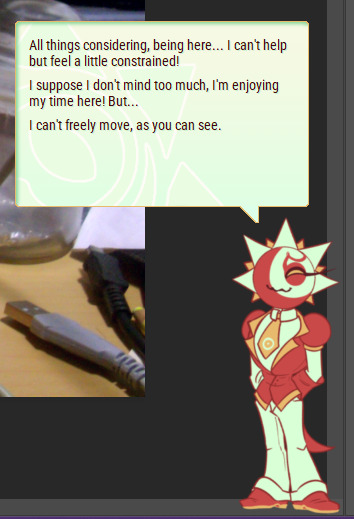
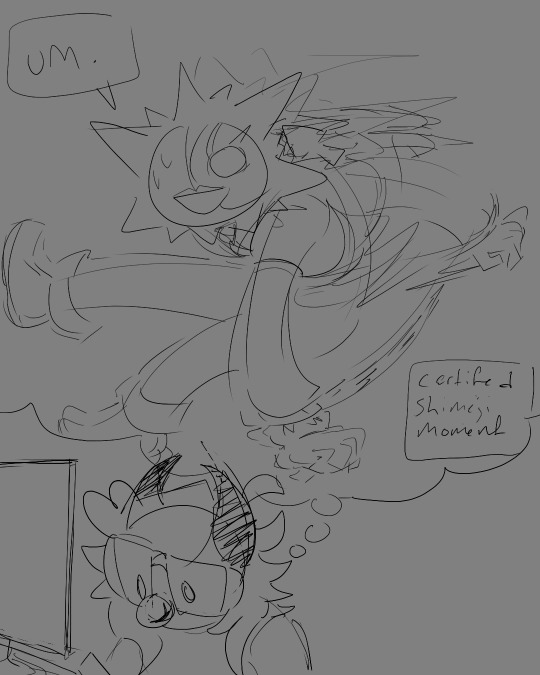
anyways can recommend the desktop buddy 10/10
#doodles#aster assistant software#rigel#genuine recommendation btw if ure a fan of desktop buddies/toys/liked shimejis in the day#the engine itself is also wild in terms of functions which itself turns into a useful tool if you know how to mess w/ it#the joke w/ the doodle is that they stand in place where as shimejis would walk around the screen#you can drag ghosts around the screen but they dont have the animation shimeji has which adds a bit of oomf when dragging them around#different functions for different apps even if they fit the same category i suppose
4 notes
·
View notes
Text
I’m rewatching 13.15, A Most Holy Man, right now, and... and I remember when it first aired. The reaction was largely “meh,” or “the noir format doesn’t really do it for me and the episode was kinda boring overall.” It’s possibly the s13 episode I have the least amount of posts for on my blog. It was largely skimmed over as mostly irrelevant, with the only takeaway being:
A. They got the macguffin they needed to progress the A plot by the end of the episode
and
2. They really should’ve cut that scene of Dean going on about how he’d kill everyone who tried to steal his car...
But... this was a Dabb episode. I wrote this post back in May, but I think it merits an additional look now:
https://mittensmorgul.tumblr.com/post/184946657745/so-im-still-out-ahead-of-the-tnt-loop-but-i
Because this single episode functions as a microcosm of their entire lives, at least thematically, if not in a 1:1 fashion. I mean, it is just a 42 minute episode. There were only so many twists and layers they could reasonably shove in, and the Rule Of Three is a convenient metric for demonstrating the pattern in narrative shorthand that invites us to consider the unspoken “etc. etc. ad nauseum” ourselves.
I’d go into the entire structure of the episode, but I’m hoping that just explaining the outcome-- after reading the post I linked above-- everyone will be able to see the parallel itself without me having to write 5k words on the subject today. :P
Let’s start with the exchange at the end of the episode that prompted this realization. Because it’s a bit of chicanery:
FATHER LUCCA: I think I got shot. [DEAN lifts up FATHER LUCCA’s shirt to see only a little blood.] DEAN: Looks like he just grazed you. A few more inches to the left and, uh... FATHER LUCCA: It’s a miracle. [SAM and DEAN, with FATHER LUCCA behind them, search the warehouse and find GREENSTREET still hiding.] GREENSTREET: I didn’t know this would happen. I… I’ll give you anything you want, huh? DEAN: The blood, where is it? GREENSTREET: It, uh… doesn’t exist. SAM: You… what? Wait a second. You told us– GREENSTREET: Exactly what you wanted to hear. It was just a bit of… DEAN: Chicanery? GREENSTREET: Exactly. DEAN: Well… chicane this. [DEAN punches GREENSTREET to the ground.] ACT FIVE EXTERIOR – WAREHOUSE – NIGHT [There are police cars outside the warehouse. A policeman leads GREENSTREET to a car and sits him inside.] GREENSTREET: No, no, no, no. Wait. Don’t – you – you – you’ve made a mistake.
For a refresher, Greenstreet was the author of this entire bit of chicanery. For a while, it appeared as if it was actually each of the other people involved:
Margaret Astor, the first person we meet, and also the one APPARENTLY holding all the cards when they walk into the final deal, who ends up backstabbed (well shot in the back anyway, close enough) by her own assistant
she sent them to Greenstreet, who introduced the term “chicanery” to the narrative, which I’m gonna focus on next, because despite all his plotting, his narrative didn’t end the way he wanted (he’s getting hauled off to jail, but heck, at least he didn’t end up dead like most of the rest of these conspirators...)
Greenstreet sent them to Scarpatti, with the partially true information that he’d been the one to have the artifact stolen in the first place, only to learn that it had been stolen from his man in turn...
(and remember, the skull isn’t actually what Sam and Dean need... it’s the currency they believed they needed in order to trade for what they DO actually need... it’s a bit of a chicane... which I’ll get to... sorry for this meandering on the way to the conclusion, but this little side journey is 100% relevant... you’ll see what I mean in a minute)
While investigating Scarpatti’s side-detour, they end up having to investigate a murder, and inadvertently stumble over Father Lucca Camilleri... but Sam and Dean have no idea that they’re now traveling through this episode with the thing THEY actually need. But rather than just... take what they need because that fact hasn’t been revealed to them yet, or even continue to pursue the currency they believe they need to trade for the elusive thing they need, they selflessly choose to do the morally right thing despite believing that in doing so they are forfeiting their chance to get the macguffin they need.
Ain’t it just Winchesters vs The Cosmos on a microscopic level?
Because one thing I’ve learned about Dabb as showrunner is that his absolute favorite thing is gleefully pointing back at canon and explicitly clarifying things. It’s not always obvious, he tends to be incredibly subtle, but if you’re looking for it, it’s impossible not to see in pretty much all of his writing. He LOVES messing with prior perception, and making us work for the satisfying moment where all the pieces fall into place.
Chicanery and the chicane. THAT ITSELF IS A CLARIFICATION. From vague to specific. Because “a chicane” is a very different thing than “chicanery.” And it’s all a bit of a winding deception.
For reference, the definitions of these two very different words:
chi·can·er·y /SHəˈkān(ə)rē/ noun, the use of trickery to achieve a political, financial, or legal purpose. "an underhanded person who schemes corruption and political chicanery behind closed doors" synonyms: trickery, deception, deceit, deceitfulness, duplicity, dishonesty, unscrupulousness, underhandedness, subterfuge, fraud, fraudulence, legerdemain, sophistry, sharp practice, skulduggery, swindling, cheating, duping, hoodwinking
and
chicane (/ʃɪˈkeɪn/) noun, a serpentine curve in a road, added by design rather than dictated by geography. Chicanes add extra turns and are used both in motor racing and on roads and streets to slow traffic for safety.
What the definition of “chicane” doesn’t provide is that in auto racing, a chicane isn’t seen as a “safety” measure, but an obstacle. If you’ve ever watched road racing, the chicane is where a lot of drivers wipe out. It’s a choke point where everyone HAS to slow down, but when you’re RACING each other, the objective is to remain out in front, you know? Jockeying for position, trying to get through the obstacle as quickly as possible to get back to direct racing toward the finish line. So while a chicane literally slows the racing by design, forcing drivers to adapt to the physical reality of safely navigate through the pinch point while not wrecking themselves, they need to maintain absolute focus to retain their position, as well. It’s not about slowing down for safety but about finding the balance point between “safely navigating through without wrecking myself or being wrecked by the other cars trying to achieve the same objective I am” and “but we’re still racing and I can’t let anyone pass me so I’m still gonna push it as fast as I can while still conforming to the laws of known physics.” It’s... difficult.
THREE TIMES in this episode, they use the word “chicanery” before Dean clarifies it to “chicane.” For reference, out of the other 306 episodes of this show that exist at the time of writing this post, they’ve used “chicanery” a grand total of ZERO other times. Seems significant, yes?
In the same way the show has frequently used Wizard Of Oz imagery to convey these same points, with the reminder in the end of the “you had the power inside you all along” sort of themes, this episode takes it one step further. Which... logical considering the nature of the spiral narrative, that when it comes around again, the circumstances aren’t exactly the same. Think of it in terms of that racetrack with the chicane.
In the case of the plot of this episode, a similar comparison can be drawn to The DaVinci Code, since through most of the wild goose chase running through all the games and puzzles, the guy is literally traveling with the object he seeks. It just doesn’t become obvious, like with Dorothy and her Ruby Slippers, until they’ve worked their way through all the puzzles and subterfuge along the way. As Dean says in Scoobynatural when Sam points out that if he knows how the episode ends, why don’t they just get to the point already, and Dean replies “Because sometimes it’s about the journey.” Rather intuitive meta observation about the point of the narrative structure, yes?
Back to our road race analogy now, after passing through the chicane chicane. Every lap, the drivers are driving through the same essential course. The shape of the road doesn’t change in the most fundamental way. The same parts are still paved, the walls around the edges don’t move, etc. But each time they drive around, other conditions vary. Their tires wear down so their traction changes. Heck, the drivers themselves are wearing out physically and mentally. Maybe a dude’s just thirsty or has an itch on his nose or just has to pee real bad. Maybe the wind speed or direction has changed. Maybe the sun has moved so different turns become more tricky with a glare in their eyes. Their engines are slowly shifting as wear and tear of operating at a high performance level alters performance. Their brakes might be wearing down. They may be in need of more fuel and are driving more conservatively, or may have just gotten new fuel or new tires or made some other alteration to their car that shifts not only their ability to go faster, but changes how they handle corners, etc. But there’s also the factor of all the OTHER cars driving around them. Maybe they’ve hit the chicane all by themselves because they’re out ahead of the pack (or trailing far behind it). Maybe they’re clustered tightly together with other drivers. Maybe there was a wreck that altered the road surface... cleaning up fuel/oil spills, sand or dirt having “spilled” out onto the road surface, maybe a slight drizzle started making it more slippery, or even random trash has blown from the stands into the road, or debris from a wreck-in-progress hampers their progress. There are SO MANY FACTORS at play that make each lap around the course an entirely different experience, you know?
Same with the spiral narrative. The major landmarks might be similar, but everything else is new.
And the moment Dean says “chicane this” and punches the author of this series of events in the face, that’s basically 14.20, yes?
They’re tired, and they’re on the last lap, and they’ve been through this chicane so many times now. And they’ve just been told that after every lap, Chuck refused to wave the checkered flag. They kept reaching the finish line over and over, only to discover it was also the starting line and the race was still going. And each time through Chuck’s big chicane, he’d deliberately change those variables, so the more experience they gained on the track, there’d always be a bit of new debris to navigate, a new difficulty level added.
And now in 14.20, it’s like they finally caught him in the act of throwing thumbtacks down on the road, you know? They caught him at his tricks.
And like, to use a favorite metaphor of Dabb’s, it’s like the roadrunner and the coyote. Only the roadrunner had always known all along that the coyote was laying traps for him and always found the most hilarious ways to foil the coyote’s plans and turn it back around on him. It took them 14 seasons for TFW to finally pull a roadrunner.
This has always been Dabb’s ending, because it’s actually the story he has been telling all along. The spiral’s broken, and instead of continuing lap after lap with no end in sight, they’ve finally realized they can just... stop driving in carefully paved loops and drive in a direct line to the finish.
(and maybe the only way to make it to the finish is to pave their own road around all of Chuck’s chicanery... it’s gonna be some heavy lifting and some rough off-roading, but it’s the only way to get off the track to victory lane)
(apologies, this is the sort of place my brain goes when Mr. Mittens is watching nascar at Road America in the background... but it’s super apt, and full disclosure, I started writing this about an hour before he turned the tv on. I was already on this road course >.>)
#spn 13.15#spn 14.20#dabb vs cars#LOL I SWEAR THAT HAS ALWAYS BEEN MY DABB TAG >.>#it's spirals all the way down#the scheherazade of supernatural#this is so meta it's actually hurting my brain and i need to go lie down now#s14 hellatus rewatch#if you say 'mysterious ways' so help me i will kick your ass#welcome to the final lap please buckle up we're gonna be cutting through the grass now#spiders georg of the tnt loop
33 notes
·
View notes
Text
The Arks
The Arks were massive starships created by the Union of Earth, Martian Free Colonies, and the Outer Sol Outposts at the end of the Golden Age of Sol, having finished construction between 2497 and 2499. Even in the present time of human civilization, the Arks are the greatest feats of engineering ever achieved by the human race, as none of each of the current interstellar nations have come close to replicating anything close to them, in terms of sheer scale.
Three arks were built, each capable of holding hundreds of thousands of humans at a time and suspending each of them in cryogenic stasis for upward of a thousand years, though that number is merely an approximation. They were each piloted remotely by an artificial intelligence calling themselves Diane, Parrish, and Hafizah. Maintenance drones took care of keeping the arks in working order as well as cleaning the halls and military drones were placed in storage, set to be activated in the event that the ark found a planet capable of harboring human life.
Despite being humanity’s best hope at survival from The Infestation on Earth, the arks were not given any predetermined coordinates and were designed to last ‘almost indefinitely’ in the event that the AI pilots, for any reason, were unable to find a habitable world in the thousand year time frame that the hibernation bays would be operational.
Arks
The Mahayana—The first ark ship that entered development made with the intent of harboring the ruling elite of the Union of Earth, Free Colonies, Venus Space Stations, and Outer Sol Outposts. Both, government officials and corporate leaders, were reserved spots in the Mahayana. Later, leading scientists and their families were reserved spots. Hafizah is the AI integrated in the systems of the ark and is the only one of the ark AIs still in use by modern humans.
The Theravada—The second ark ship built and piloted by the AI calling itself Diane. The Theravada suffered several power fluctuations during its journey and has had Diane’s mainframe completely removed since arriving in The Viridis Cluster.
The Vajrayana—The last ark ship and the most ineffective one. With a faulty power regulator, power shortages occurred frequently. Prone to problems, of the three arks, The Vajrayana is the only one not in operation after arriving in The Viridis Cluster. It was piloted by Parrish.
Technology
The arks were the most advanced star ships developed by humanity and each of them shared similar designs. It was intended that the occupants would spend the first few years outside of the hibernation pods to get acclimated to life on board the arks. Mixed with the idea that the arks may either be repurposed into colonies or stay in a planet’s orbit, the arks were built with central hubs; massive park-like centers containing residences, offices, shops, restaurants and many recreational facilities. These central hubs were capable of detaching from the arks in massive modules and would serve as the building blocks for the first human colonies on alien worlds.
Because humanity was not an interstellar civilization, the engines and thrusters may be considered archaic by the modern human nations. Each ark is outfitted with experimental Le Guin-Drives, which were extremely inefficient in terms of fuel output and power consumption, leading to many system failures in many parts of each ark respectively.
With artificial intelligence technology having been used extensively in human society during the Sol Golden Age, it was decided that it would be used to pilot the arks once all occupants were placed within cryogenic stasis. Each ark held servers dedicated to housing the AI mainframe, each of which being almost direct copies of one another and programmed with the directive of protecting human life.
Despite being carbon copies, each AI developed their personalities differently. The Mahayana’s AI called itself Hafizah and was found to be curious about the humans it would be escorting to a new world, finding joy in interactions with the science divisions on board during the Mahayana’s construction. The Vajrayana’s AI, Parrish, was vigilant and mindful of its duties, taking pride in its role as humanity’s savior and allegedly having envisioned its destiny of watching the first human civilizations rise up on a new world. The Theravada’s AI simply called itself Diane and was arguably the most robotic of the three. It held little regard for its own ‘emotions��� and held its prime programming above all else.
Despite what many may think about the arks, they were not all built equally. The Mahayana was built with the most state-of-the-art hibernation modules that would not only cryogenically suspend its occupants, but also allow them access to a connected virtual world where they could spend the duration of their journey to their destination. Because it was built first and was the primary focus of the human race in Sol, The Mahayana was almost completely flawless and did not suffer as many power shortages as its sister arks and those it did suffer from were rectified with ease.
The Vajrayana was the most shoddily built of the three arks, suffering from numerous power shortages as a result from the hastily put together Hyperion Power Generators. Because the ship suffered greatly from fluctuating power, many of the ark’s modules were powered down in order to conserve energy and eventually one of the hibernation bays was powered down, resulting in the deaths of nearly 15,000 human colonists.
History
The Infestation
In the wake of The Infestation rapidly spreading at an alarming rate within the Kazakh Steppes, the Union of Earth determined that quarantining the area was simply not enough. The local wildlife had become infected by the fungus and soon had been carriers of the spores through the wild. The Infestation slowly consumed everything in the wilderness turning dead material into twisted puppets of what they once were. U.E. military tried extensively to eradicate the Infestation, via high ordinance explosives and chemical weapons, but yielded no results.
U.E. scientists determined that the growth of The Infestation would snowball rapidly if it were unable to be contained or destroyed. Signs had shown that each life form consumed by the fungus had not only acted and performed normally, but they showed signs of slightly higher intelligence. Human soldiers who attempted to eradicate the growths were attacked by infected wildlife and those consumed by the fungus not only produced spores, but were able to operate normally, showing enhanced motor functions.
By 2434, the nation of Kazakhstan had been completely consumed by The Infestation. It was determined that Earth was no longer safe and mass evacuations in neighboring countries saw a massive influx of refugees on the Martian Free Colonies and the Outer Sol Outposts. Scientists proposed the idea of creating the arks, in the event that the Infestation ever got in control of the whole planet and managed to learn how to use spacecrafts.
The Union of Earth approved of the project and construction of the first ark, dubbed The Mahayana, began immediately in 2436 in orbit of Neptune. Initially, the construction project was classified and hidden from the public eye.
The Sol Dark Age
There are almost no records of the time between 2436 and 2499, but a number of assumptions can be made between the time frame. This is commonly referred to by modern humans as The Sol Dark Age, a term coined by The Velutarian Star Duchies.
It can be assumed from several terminal entries by Alexander Stinekirk, the Director of Bioscience of the Omnigenics Corporation, on the Theravada that its construction was the result of mounting public unrest on Earth as the Infestation grew exponentially and the discovery of The Mahayana’s construction in Neptune’s orbit. Some time in the 2450s, The Infestation had slowed down its rapid expansion on Earth after orbital satellites unloaded nuclear payloads in an attempt to kill Infestation ‘Control Nodes’. It was thought that some of the organic constructs produced by The Infestation functioned as a kind of ‘brain’ or ‘operation centers’ that directed consumed life forms.
The Chrysa Corporation holds historical documents dating back to 2479 that hold names of corporations, that no longer exist in modern human societies, and their devotion of massive amounts of resources to build each of the arks. On top of allocating resources to finish construction of the arks, anyone employed to assist in the construction of the arks were allegedly granted spots, alongside their families.
By the 2480s, The Infestation regrew its destroyed organic tissue and once again began to expand. By this point, anyone who was left on the planet was likely doomed to be consumed by the biomass as the U.E. had all but collapsed and the governments on Mars, The Moon, in the space stations above Venus, and in the Outer Worlds refused to devote their ships to evacuate the rest of Earth’s populations in fear that it would allow the Infestation to spread off the planet.
Construction of the arks were completed in the late 2490s and early 2500s. There are numerous recorded terminal entries by the hundreds of thousands of occupants in the Theravada and Mahayana after they had all embarked and left the Sol System. Many described worries for friends and family who were not chosen to be occupants on the arks. Startlingly, there are terminal entries that suggest The Infestation managed to achieve space flight and gave chase to the arks as they began to leave the Sol System. However, there are also records of rouge squadrons hoping to board the arks, so the reports of The Infestation achieving space flight may have been nothing more than paranoid hysterics.
Interstellar Space and Arrival in The Viridis Cluster
When the arks entered interstellar space, the human occupants entered cryogenic hibernation and were not set to awaken until the ark’s respective AIs found a habitable world or in the event that the time spent in hibernation passed a thousand years, as the pods were not expected to run without malfunctions afterward.
It is not known when or why the Arks separated from each other in the middle of their journeys, but the resulting destinations are even more curious to modern historians. It is thought that the AIs of each ark sought out a habitable world and would attempt to contact one another if one had found a suitable planet for humanity.
Interestingly enough, AI archives aboard the Mahayana report electromagnetic disturbances and total loss of control of the ship in 2755 before regaining it in 2757. It’s not known what caused this interference and loss of control, but many assume that that was the reason for the Mahayana arriving in the Viridis Cluster.
Some time in 2892, several occupants within The Theravada were awakened for unknown reasons. Among the awakened occupants were Katherine Stinekirk, Sindri Hartvigson, and Anvik Kestrel—three of the most notable figures associated with the birth of the idea of The Terran Interstellar Union—among several other occupants. In 2894, Diane was deactivated and the awakened occupants of The Theravada were left to pilot the ship manually.
By 2914, The Theravada entered The Viridis Cluster and, by 2936, entered orbit of the world of Jardin. While in orbit, Katherine Stinekirk launched several scouting drones to survey the world for the next 5 months before deeming it habitable and awakening the humans on board. When the ark’s central modules landed on the planet, the main control module was left in orbit to transmit a signal out to the other arks, in hopes of coming into contact with the other human survivors.
Unknown to The Theravada, The Mahayana arrived in the outer rim of the Viridis Cluster in 2876, set off course from its original destination. Hafizah discovered several lush worlds and deemed them capable of harboring life. Following protocol, it launched several scouting drones from orbit of the world that would later be known as Velutaria. By June, 2877, humans landed on the world and established themselves.
The Vajrayana, however, fared worse than its sister arks. With systems failing in multiple regions of the ship, Parrish found itself desperate. With more than 15,000 deaths due to power losses in the hibernation bays, Parrish cut off power to the central engines and allowed itself to drift forward for the rest of its journey, hoping any nearby scans would find habitable worlds.
It is unknown how The Vajrayana ended up in The Viridis Cluster as well as when exactly it found itself there. Parrish has long since powered down, never fulfilling its goal of seeing the humans under its protection emerge from their hibernation and populating a brave new world. The Vajrayana managed to slow down significantly enough to survive a crash landing on the world of Azura Prime. It’s not known how the occupants managed to survive or when they emerged from their cryogenics pods, but when they did, they were met with a hostile alpine wilderness.
Legacy
The arks, naturally, are held in high esteem for saving the human race and allowing them new beginnings in The Viridis Cluster. The Theravada’s control module has since been retrofitted into a museum in orbit of the Terran Interstellar Union’s capital world of Novus Terra. Artifacts and technology are put on display, as well as access to copies of terminal entries made by the crew of human colonists who once lived on board The Theravada. Those in The T.I.U. value remembering the past and hold idealistic dreams of returning to the Sol System and exterminating The Infestation.
The Mahayana’s control module remains completely functional, retrofitted and upgraded with modern technology. The Velutarian Star Duchies often use The Mahayana as a holy relic of the past where many scholars and pious pilgrims visit. It is believed that The Mahayana is under direct control of the Velutarian ‘God’ Frea and when it enters systems within Star Duchy space it is seen as a blessing and marks good fortune for the system .
Even the Vajraya Compact, who knew of only the hollowed shell of The Vajrayana had taken to naming themselves after the ship that saved them from extinction. The capital city of Soteria is made from the remains of The Vajrayana and later generations of the Vajraya erected statues in honor the one named Parrish, who is often credited with the salvation of the Vajraya people and gave them the building blocks of Vajrayan society.
Each ark contained records of human history, modern science and mathematics, and blueprints for machinery of all kinds in hopes that the survivors of humanity would be able to use them to continue progressing the human race. Despite this, The Terran Interstellar Union is the only faction able to make use of the archived information, making them one of the most advanced human interstellar nations. Their education programs attempts to make use of as much information from the archives as possible.
The Velutarian Star Duchies, however, were only able to make use of the technological archives as the records of human history had been wiped when the ship was disrupted by an electromagnetic disturbance. Because of this, several generations of Velutarian humans suffered from a lack of appropriate governance until they united under the banner of an empire who’s Emperor and Empress were able to hear the words of the Frea, the Velutarian people’s deity. Since then, the Velutarians have begun to progress culturally and have begun to make more innovations technologically.
The Vajraya suffered the worst, because of the Vajrayana’s crash landing on Azura Prime. Currently, their knowledge and technology comes from a research agreement with the Terran Interstellar Federation, who has helped propel the Vajraya’s technology by nearly 700 years.
#scifi#fiction#writing#writeblr#wikia#facts#not really#book ill never write#science fiction#cool stuff#pupupu#Viridis
4 notes
·
View notes
Text
No Driver’s License: Session 36
No Driver’s License is a Madoka Magica game I’m running for five players, using a homebrew of Yaruki Zero’s Magical Burst system. It follows five magical girls as they deal with an upheaval in the world’s magic system caused by some strange new three-eyed Incubators. They have to figure out what’s going on, who to trust, and how to put a stop to the cycle of despair.
I post session logs and omakes weekly sporadically, both as a reference for the players and for anyone who wants to follow along with the party’s misadventures.
[adventure log- read from the beginning]
[session 35]
Last time on No Driver’s License, the party managed to beat what should be the final combat encounter. They caused Honoka Midarezaki to witch out, leaving behind only Katou Kimiko, and... well, is that going to be enough? Because... Emiko beat Ibara to snagging Kimiko’s Soul Seed, and the situation might demand further defusing.
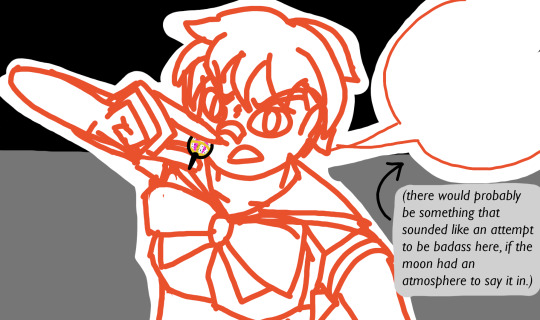
So, the big question- are we reviving Kimiko, here?

Emiko vehemently denies any intention of doing so, but... well, Fumi-chan’s still being a little shit.


Ibara points out that they’ve got other options on hand, but Tama-chan refuses to do the reviving, too- she intends to just put her on ice and keep her from reviving indefinitely. And... Nishi’s on her side, here. That leaves zero willing Incubators.
Emiko’s in no hurry, though- she’d rather just have everyone here back the fuck off, please.



There’s more arguing that wants to happen, largely because Emiko and Sakura want to do it- which Ibara is opposed to doing here, now. Yukari and Makoto are more or less behind her, on that count.



Emiko ends up agreeing- she would rather not bring Kimiko back to life here, surrounded by enemies and liable to panic and lash out.

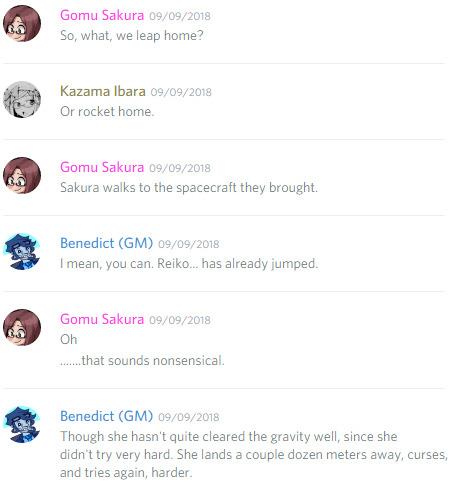
Tama-chan and Nishi try to urge the team to take out Emiko while they have the chance- they sort of haven’t been around for any of the... learning about the cannibals and how they’re maybe redeemable, and just see a chance to put a stop to them. Yukari explains that they want to recruit the cannibals, which... the Incubators are rather surprised by. She explains her plan, but Tama-chan has doubts.

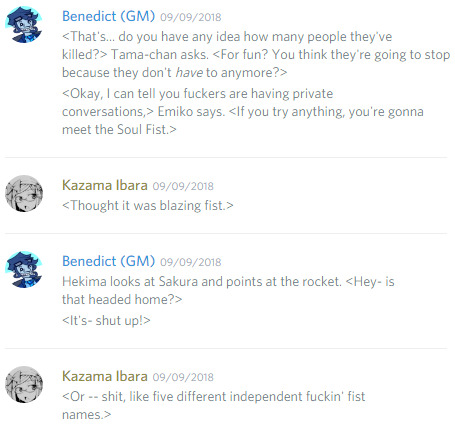

Meanwhile, in the rocket, Makoto and Sakura are catching Hekima up on the situation with the cannibals. She, like Tama and Nishi, is not convinced recruitment is viable- but for different reasons.


Sakura explains that they intend to rewire magic itself to not work that way. Her plan for that, though, is pretty ambitious- her step 1 is “use magic to bootstrap a superintelligence, and have that fix magic for us”.

Answering her questions means looping her in on... the whole Hell Engine thing, and the Devil, and they’re not sure whether to divulge all that right now. An inquiry re: her personal motivations is made, wherein she affirms that all she wants is to survive.


Sakura only then notices Nishi’s presence, and asks her some questions about hacking the Hell Engine to rewire magic.

Hekima keeps pushing to be told about their mysterious source of Grief relief, not allowing the subject to be changed. They’re... still not sure if she can be trusted, though.

Sakura’s ensuing Heart roll is... middling. Hekima doesn’t exactly react angrily to that, but...

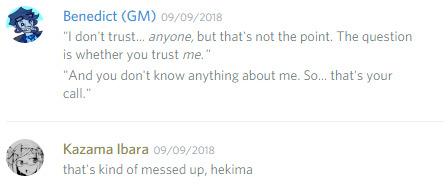
Back at the ranch- I mean, back on the moon but like a dozen meters away- Yukari and Tama-chan are still going at it over the cannibal plan.

Ibara tries to get things back on track.


That’s... good enough for Yukari, who tries to cement that stance. If she can prove they don’t need to eat anyone anymore, will Emiko commit to not doing soul cannibalism?
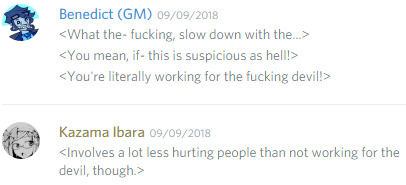

Emiko’s not really ready to commit to anything, and she’s worried everything is a trick, and doesn’t like how Yukari won’t actually explain what the plan is. Ibara tries to put it in plain language, which gets her a little more cooperative.
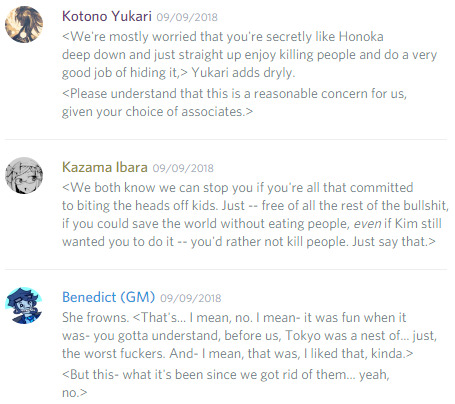
Yukari and Ibara describe the Hell Engine and the Devil in... terms vague enough to not give Emiko enough information to fuck with them, but enough to give her something to work with. Emiko’s final stance here is... she isn’t going to just immediately go along with it. She’s going to go home, revive Kimiko, and talk with her and Yoshe as a team about whether this is a good idea, before committing to anything.
That agreed upon, it’s time to go home. Ibara goes and checks on the crew in the perfectly functional rocket ship they have, where they’re still trying to figure out Hekima.
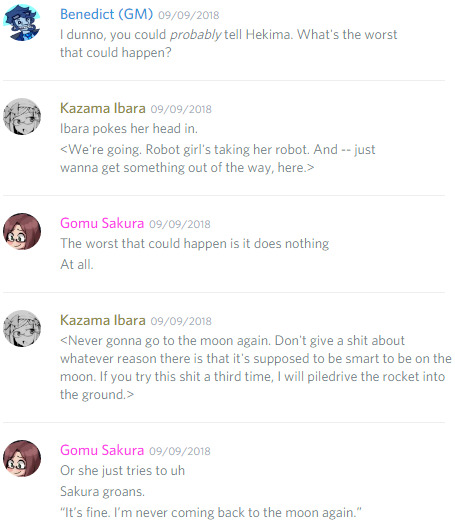
WELL I SURE HOPE SO
Meanwhile, Yukari has one last thing to do before they take off. She wants to get Orino to shrink down the Hell Engine so it can be made portable- and more importantly, able to be hidden from the cannibals if they find out what it is. Seina helps her track Orino down with the pre-existing telepathy connection they made when they arrived.
Ibara and the others, though, are getting impatient- and Yukari can just teleport home, right?

So they... sorta take off without her. Sakura rolls a crit on Heart to pilot it home, and Ibara... assists.

That all goes... mostly well. There are some Things that happen when they land, but let’s resolve Yukari’s quest first:
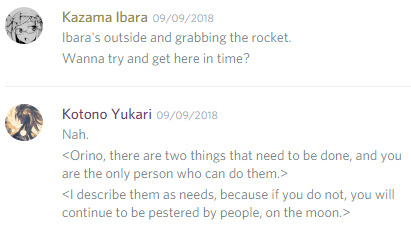

Tama-chan is here chiding her and calling her an idiot, but mainly about the “telling the cannibals about important stuff” thing, and not the issue at hand. Yukari... takes it as kind of a revelation, though.
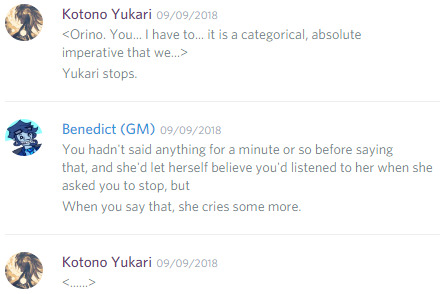
Yukari has a whole spiel about how she isn’t sure if Honoka still exists, what that relationship will be like, agonizing over that...

She goes on for a while about how maybe she’s broken and intrinsically evil and just ought to embrace her destiny as a plotting villain who doesn’t care about other peoples’ feelings. Tama-chan sort of ineffectually tries to derail that.
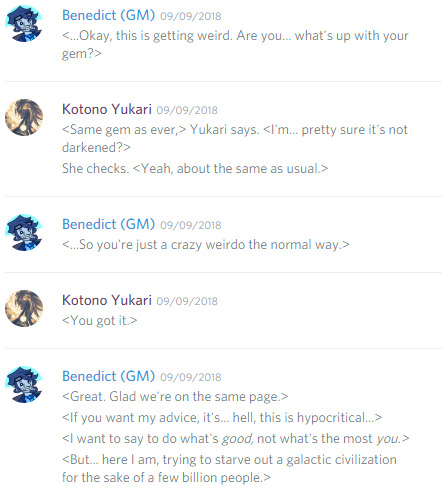
Yukari eventually comes down from her self-loathing high, and decides against pressuring Orino further. Tama-chan still isn’t happy about the cannibal plan, but acknowledges that she can’t really stop it, and vanishes. (By “vanishes”, I mean she self-destructs the Kyubey she’s piloting, and auto-recalls her gem to her base, but same deal plus some gold rings for Yukari.)
Meanwhile, on the way to Earth, some stuff happens. First, Makoto gets in contact with a friend:



Before I can show you what happens when they land, though, I need to rewind to a non-player omake that happened simultaneous with the session.
Rather than paste the whole thing: Olivia Gumm is in the bunker, working on her manga. She’s mostly on track to meet her deadline, but then Takamine Mitsuki shows up, and starts to ask questions. Olivia draws a fantasy yuri manga which is supposed to be all-ages, but she’s not sure if the Takamines are traditionalists and isn’t sure whether to explain it to Mitsuki.
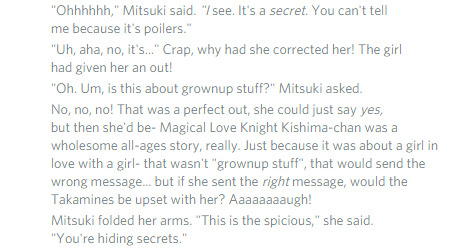
Mitsuki turns out to be pretty open-minded when Olivia starts explaining, and from what she says about what her parents have said about the subject, Olivia won’t get in trouble for corrupting their daughter or anything. Mitsuki eventually runs off to ask her mom more about “homerphobia”, and- whoops, then Olivia breaks her pen.
Meanwhile, with Ibara’s delinquent buddies...
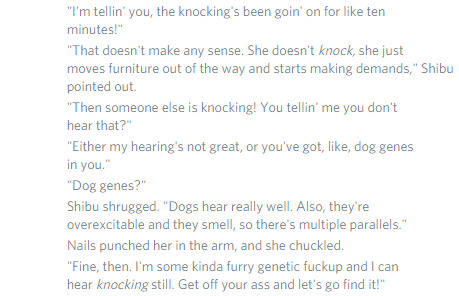
After some arguing over whether they’re going to go investigate, settled by Ibara’s sister Nano threatening to sic Ibara on them if they don’t quit making a ruckus, they go and find the source of the knocking.
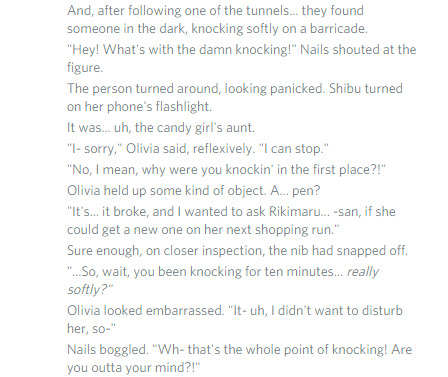
The delinquents push past the barricade, ignoring Olivia’s horror at having broken Reiko’s rules, and find... no one. She’s missing. (She’s been kidnapped to the moon by the Devil.) Shibu fires off some texts to Ibara:
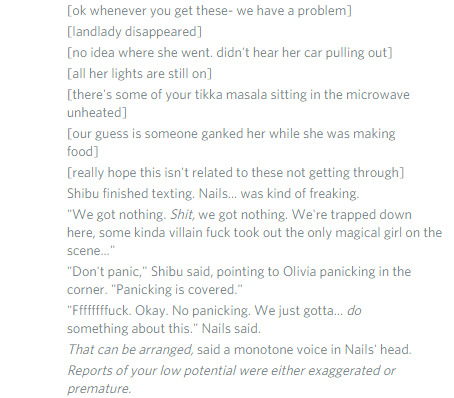
So, that’s what happened while they were gone. As they re-enter the atmosphere and regain cell reception, Ibara gets those texts.
Sakura lands the rocket in the Gyoen National Garden, the park where Reiko’s bunker is hidden. The thing’s decked out in Somebody Else’s Problem amulets, so they’re fine muggle-wise. Ibara heads down to check in on Reiko and the bunker inhabitants.

As it turns out, Shibu was able to keep Nails from contracting, despite Nails being extremely excited to be told that she has magical potential and could contract. So, that’s a bullet(?) dodged, at least. Everything down in the bunker seems pretty much fine.
Seina also heads down there- with Cho clinging to her arm, in front of her parents, an embarrassing situation that will be addressed in a couple sessions.
After checking on the bunker folk, Sakura is the first to head upstairs and outside, where she meets...


Sakura has... a bit of a breakdown, worrying about her purified trauma tracks. She’s worried about a feeling like life is pointless.


(Sheesh, Hekima.)
Sakura ends up asking Hekima to take a look inside her head, see if she can find out what witching did to her. Hekima is totally up for it, it seems.
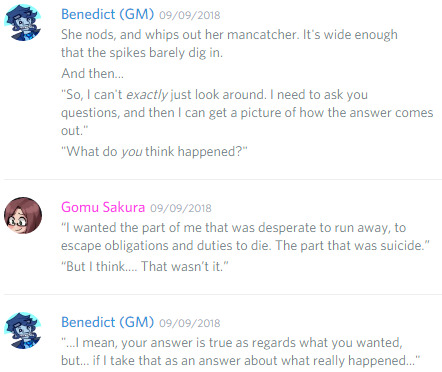

They spend a while psychoanalyzing her, through Hekima’s maybe-not-super-reliable lens of pulling on true and false statements and guessing about the underlying neurology. Hekima’s verdict is that Sakura is just... very susceptible to emotional manipulation, prone to mood swings and wild behavior in response to minor stimuli. Hekima, as an old-school magical girl, is more than happy to catalogue her mental weaknesses.
And then... well, Hekima has her mancatcher around Sakura’s neck, and the thing to remember is that this sort of exploratory brain imaging stuff is not the primary function of the ability. The primary function of the ability is to forcibly read someone’s mind. When Sakura says she’s done and asks to be released...

They make contested rolls, and it’s close, but Hekima barely beats her.

(The ability description was cribbed from an unused character sheet Farn made, which I decided to remix a bit to make Hekima.)
So, the result of that is...
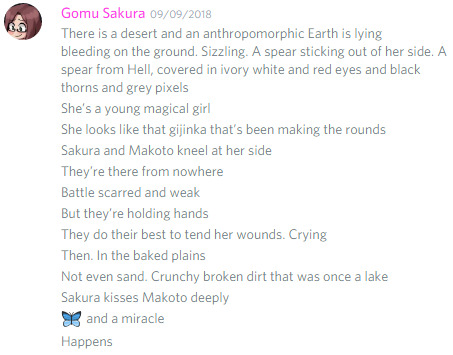

She tries to say “I can’t tell you that”, but fails, because that’s a lie- she can tell her that, she just won’t. Instead, she continues on the obfuscation tack.

Then Sakura tries to punch her, but fails her roll.

So... that’s not ominous.
Next time on No Driver’s License: Sakura and Yukari have a heart-to-heart over some curry, and Makoto pays a visit to the cannibals to see how their team discussion has been going. I’m sure this will all wrap up super-neatly.
4 notes
·
View notes
Text
Some Kathy Angst for Y’all
saint-j92000 submitted:
Alright, let’s try this again, from the top;
Let’s say the tragedies befalling Matt are entirely supernatural in nature. They’re far more contrived and elaborate then scenarios most kidnappers would engineer, and he really does just fall asleep in bed and wake up somewhere else. Edd, Tom, even the neighbours have all felt a growing sense of paranoia, or felt odd things from time to time, or had the occasional vivid nightmare, but Matt is receiving the full brunt of the horror initially. The entity causing this is not unlike that which causes everything in the Haunted Game AU; it is a formless, shapeless, wholly evil “thing” that preys on the vulnerable, tormenting them with their worst fears and feeding off of their utter terror, keeping them in a constant cycle of hysteria to sate its seemingly never ending greed. It has preyed on countless people already; the boys and the neighbours are only the latest targets, and no doubt more of Durdham Lane’s residents will be claimed in due time.
Almost as soon as Kathy sets foot in this universe, something feels terribly wrong. At this point, she’s still fairly new to the “trying to save failed timelines” thing, and though she’s seen some weird stuff nothing has ever felt this… rotten. Were it a more experienced Kathy, she’d see it for the doomed universe it is, but for right now, she’s unaware. However, as she senses the entity, it too senses her; she is, after all, a magical being of considerable power herself. It recognises itself as the more powerful one, in terms of raw magical aplitude, but it is smart enough to know that overestimating ones self and underestimating the enemy is a rookie mistake. So it refocuses it’s attention, for now, the boys are spared. Kathy, on the other hand…
She doesn’t realise how close it is to her until it is far, far too late. “Far, far too late” in this context being when her heart just… stops. And out in the woods with noone to administer CPR, that’s a problem. She, of course, dies. The entity, initially, is satisfied, but it quickly runs into a problem:
Kathy stands back up.
I dunno if you planned for her to be functionally immortal, but for the sake of this scenario I’m gonna run with it; she cannot permanently die, and no matter how gruesome her death she will revive. The downside; that stuff still hurts, and she does technically “die” and then “revives” rather the remaining invulnerable. The entity takes a little bit to fully figure this out,as it’s attempts on Kathy’s life grow ever more gruesome.
She drowns on air. Her head collapses into itself. Her insides violently eject themselves from within as though they were bile. She is violently dismantled limb by limb. Her body temperature increases to the point that she cooks from the inside out, not unlike meat grilling on a griddle. Every last death is absolutely agonising; she’s never known such pain, and each taste of oblivion is as terrifying as the last no matter how brief. Still, she soldiers on; partially because of her innate desire to do good, and also because… well, she doesn’t have a choice, really.
Eventually, the entity realises its attempts on her life aren’t working, and it is wasting valuable time and energy killing her over and over with very little gained from it. However, it also learns something quite vital; though powerful, though functionally immortal, Kathy is human. She has the capacity for empathy, and for emotional intelligence, but most of all, she has neurosis; things it can attack. It can almost smell them on her. And that’s when it realises Kathy isn’t a pesky distraction that needs to be dealt with. No; Kathy is the ultimate mark, and fate did it a tremendous favour by dropping it in her lap.
It immediately sets to work chipping away at her mental state. The first step is easy; though somewhat new to this, Kathy has seen failures already. She’s watched the boys and their friends fail, suffer horribly, perish entirely, all that sort of thing; it plays these failures back to her, on a constant loop. Then it changes tracks; it shows her all the failures that will happen to her, or at the very least ones that could- Space Quiznos, Haunted Game, it even twists scenarios like Reverse Monster Family so that the outcome leans towards the negative. It’s low hanging fruit, but it works. It preys heavily on Kathy’s deepest fear, after all; being unable to help innocent people, especially those she cares for, despite all her power.
The entity realises that this fear goes even deeper, too. After all, Kathy is technically human; she was not born as she is, but became this way somehow. Therefor, the life she had before was taken from her. She can’t quite remember what it was, now, but the lingering sense of something is still there. Her fate was wrenched from her grasp and decided without her consultation; it was decided by someone, or something, that she walk the earth as this incredibly powerful, unkillable dimension hopping magical helper, instead of just… Kathy.
And she can’t even help people. She’s unable to do the incredibly specific thing she was forced to do, the one single thing that has kept her going as her own personal desire to help grew alongside it being her designated role.
This shatters Kathy; she tries so hard for so long not to cave, not to let the fear or the horror or the sorrow run wild as her mind is constantly assaulted by nightmare after nightmare, but when this realisation finally hits, the dams break and she weeps, openly. She begs for the entity to stop; to show her mercy. Her need to be safe, to be sane, overrides her protective nature.
It is very sweet and highly fulfilling stuff for the entity, but it is short lived; you see, in her emotional frailty, Kathy opened her right eye. Her power’s effectively went into auto pilot, and she was pulled from the entities clutches and thrown into another dimension entirely, left alone and without companion to heal from her ordeal. It… takes a little time. It hardens her considerably; not to the point that she is unable to smile, crack wise, or even snow her soft side, but she is not as naive as she was; she knows when she can and can’t help, and if she can’t help, she gets out of dodge. She has perhaps swung too far the other way though, and sometimes leaves the boys to fates they could avert, where she not so quick to rule it out as hopeless, but you can hardly blame her for what she went through. It isn’t until she happens across the reverse monster family universe where some of that original fire burns once again- allowing her to actually succeed in saving the boys and punishing that universe’s Edd for his cruelty- and it is not until she adopts them as her sons that those hardened edges begin to soften. But those are stories for another time.
The entity, as you can imagine, is furious. A truly delectable morsel, one which was effectively self-sustainable, had slipped away from it. And unlike Kathy, it CAN’T shift dimensions; it cannot follow her. It doesn’t even really have awareness of the concept, but it knows it can’t even feel her anymore; it will never find her, no matter how hard it looks.
It is with that incensed fury that it turns its attention back onto its original marks.
20 notes
·
View notes
Text
2021 Genesis GV80 3.5T review: A lead-off home run
New Post has been published on https://appradab.com/2021-genesis-gv80-3-5t-review-a-lead-off-home-run/
2021 Genesis GV80 3.5T review: A lead-off home run
Those dual-slit headlights work wonders on just about anything.
Andrew Krok/Roadshow
Nobody’s truly great at something the first time they try it, but Genesis is working to buck that trend. The 2021 Genesis GV80 is the freshly spawned Korean automaker’s first SUV of its own and, just like the heavily revised G80 before it, this midsize luxury SUV is ready to make its mark in a busy segment — and fast.
Like
Sharp exterior
Properly luxurious interior
Top-notch infotainment graphics
Don’t Like
Ride could be softer
Just-OK fuel economy
A stunner, inside and out
The 2021 Genesis GV80 really commands attention. One driver rolled right up next to me on the road and honked the horn of their sedan until I turned my head, at which point I was met with a car full of thumbs up. The GV80’s exterior is unique; in fact, I’d consider it the prettiest ute in the segment. The headlights are like no other and the way the fastback-style roof line carries itself backwards leads to a car that looks like it’s constantly in motion.
The GV80’s interior manages to impress even more than the exterior does. This lovely design is part and parcel with the GV80 experience, regardless of trim. I might not fully embrace the two-spoke steering wheel, which is a little fat for 9-and-3 hand positioning, but the layout is uncluttered and the patterns baked into the leather ooze luxury. The GV80 is right up there with Mercedes-Benz in terms of interior quality and at its price point, I’d say it actually trounces the Merc on value alone. My tester’s a little monotone with its beige getup, but there are some truly wild combinations out there, including a two-tone motif with lots of blue leather.
Everything I touch is made of either leather or metal, with high-quality knurling on the stalks and infotainment controller; the GV80’s cabin feels ultra-premium. One of my favorite parts is the climate control, which has a small touchscreen that lets me configure airflow and fan speed independent of the automatic function. Even the temperature dials look and feel expensive.
The GV80’s interior doesn’t forego function in favor of all that form, either. Sure, the door panels are a little light on storage space, but the flowing center console has a decently sized cubby under the transmission dial and the armrest opens up for a bit more storage. It’s roomy as heck, too, with a second row that doesn’t scrimp on headroom despite a slightly cut roof line. Advanced Plus trims have an optional third row as well that, according to my colleagues, isn’t appropriate for fully grown humans, but it works for kids.
On-road serenity
The 2021 GV80 is not a svelte fellow, clocking in at some 5,000 pounds with AWD and all the bells and whistles, but my tester packs Genesis’ larger engine option. The twin-turbocharged 3.5-liter V6 produces 375 horsepower and 391 pound-feet of torque, and while it might not be the most sonorous six-pot on the block, it will push the GV80 forward with alacrity. Shoot whatever gap you want; there’s more than enough torque on tap and the eight-speed automatic transmission smoothly swaps cogs as necessary. There’s plenty of throttle and brake modulation on offer for serene, dip-free starts and stops, playing into the proper-luxury angle very nicely.
Most European midsize luxury SUVs try to bake some sportiness into their existence, with relative success. The GV80 tries to take more of a pure-luxury angle to its driving characteristics and it’s mostly successful. The Advanced-trim model in my driveway comes with Genesis’ road-scanning adaptive suspension, which uses cameras to preload the suspension in the event it has to handle some nastiness, which can be a rather big deal on the automaker’s Korean home turf. In Michigan, it does a commendable job eating up gross roads, but the whole experience feels a bit stiffer than I’d prefer, even with everything dialed to its plushest setting. An optional air suspension would turn this thing into a freakin’ cloud, so here’s hoping Genesis finds a way to shoehorn something like that in here later on. The GV80 is never really exciting to toss around, because that’s not what it’s made for, but it’s plenty confident if your commute involves a few twists and turns.
The GV80’s interior is interesting, no matter where you look or where you touch. Leather, metal, it’s all here.
Andrew Krok/Roadshow
Luxury continues to be the priority when looking at other parts of the driving experience, too. The cabin is plenty quiet, thanks in part to thick glass and an active noise-cancellation system that works like the headphones on your desk. It’s a properly placid time for both the driver and the driven.
Fuel economy is competitive for the GV80’s class, but outside of that bubble, it’s not really all that and a bag of chips. 3.5-liter models, which come standard with all-wheel drive, are EPA-rated at 18 miles per gallon city, 23 mpg highway and 20 mpg combined — with premium gas, no less. 2.5-liter variants are a little less thirsty at 21 city and 25 highway, but it’s still sufficiently thirsty.
Top-notch tech
In my G80 review, I spoke at length about how much I loved Genesis’ new infotainment system — and it’s no different on the 2021 GV80, which is to say that it rules. The 14.5-inch display atop the dashboard commands attention with its delightfully calm home screen and easy navigation, whether I’m reaching to touch the screen itself or (more likely) manipulating the rotary dial on the center console. Buttons above the climate control provide quick access to the usual features like the navigation, audio or settings menus. Every corner of the system isn’t just attractive, it’s intuitive and it doesn’t take long for me to figure out my preferred way of doing things. Apple CarPlay and Android Auto are available, but not wirelessly, and as my boss Chris Paukert pointed out in his review, there is no option for a Wi-Fi hotspot or rear-seat entertainment here, which seems like a silly omission when most of the GV80’s competitors have all that. It’s not a deal-breaker, just a head-scratcher.
Only Prestige trims get the wild gauge-cluster screen that uses digital trickery to give the impression of physical depth, which means my GV80 is stuck with the tried-and-true physical cluster that includes a moderately sized info display in the middle. This is about the only corner of the vehicle that reminds me of the car’s Hyundai-based provenance, since it looks and acts like the same getup seen in cars like the Sonata. It’s fine; it does the job it’s supposed to, it’s just the only part of the cabin that I wouldn’t call special.
The home screen of Genesis’ new infotainment system is gorgeous and it changes based on the weather.
Andrew Krok/Roadshow
Every GV80 comes with an impressive amount of safety tech, including parking sensors, rain-sensing wipers, adaptive cruise control, lane-keeping assist, blind-spot monitoring and automatic emergency braking that can detect both pedestrians and cyclists. The Advanced trim throws a surround-view monitor, mirror-mounted cameras and rear automatic braking into the mix, as well as Remote Smart Parking Assist (aka Smaht Pahk), which can roll the vehicle forward and backward while the driver presses the remote from outside. It’s some cool stuff, even if I only ever use it to show off.
All GV80s also include Genesis’ Highway Driving Assist, which combines the active and passive safety aids to hold the vehicle in its lane on the highway while keeping pace with traffic. It helps reduce some of the tedium of a traffic-laden commute, but it’s a hands-on system so vigilance remains a requirement. It does a commendable job, but the GV80’s lane-centering tech can be a little aggressive at times and I’m a pretty active driver so I generally leave the system off.
Down to brass tacks
Despite embodying the full-on luxury experience better than nearly all its competitors, the 2021 Genesis G80 isn’t a bank-breaker. Starting at $49,925 including destination, the GV80 3.5T AWD Advanced before me kicks off at $65,375, which is impressive in context; a BMW X5 xDrive40i starts at about $62,000, while a Mercedes-Benz GLE450 is about a grand above that. And then there’s the Audi Q8, which commands nearly $70,000. All three of those vehicles are before options, too. Hoo boy.
It’s a weird day when a car can be both a serious value and an example-setter in its storied segment, but that’s the 2021 Genesis GV80 in a nutshell. It manages to provide an excellent luxury experience in its truest form, eschewing the notion that every vehicle needs some underlying sporty angle, while somehow beating its biggest competitors on price while maintaining quality that rivals them. You’d think that the GV80 was Genesis’ third crack at a luxury SUV, but nope; sometimes, you strike gold on the first swing.
0 notes
Text
In Conversation With Conceptual Artist Pedro Reyes
Contemporary conceptual artist and traditional stonemason; architect and activist; engineer and craftsman. The cross-disciplinary nature of Pedro Reyes' work - which encompasses performance, installation, video, sculpture, and activism - makes a strong case for multiplicity.
Acknowledging the poetry of form as well as the power of politics, Reyes' work layers complexity, humor, rigor, and design. Reyes lives and works in Mexico City in a brutalist house of his own design.
Rosie Robertson (RR) Pedro Reyes (PR)
RR: Having first trained as an architect, you now create time-based, conceptual performance art, and sculptural works; was it a childhood dream to become an architect?
PR: As a child, my grandfather was a significant influence because he taught me algebra and mythology at the same time, he would take a Greek or roman myth, and then he would pose a problem in algebraic terms. For instance, a simple arithmetic problem would be: Jason has to kill the hydra, but can only catch two heads at a time; how hard does Jason have to work? What that taught me was that you could have myths translated into a formula, and those myths could change or be rewritten using the same elements that gave me the keys to eventually perform. On the other hand, my father was also a significant influence because he taught me engineering drawing. He did not mean to impress me, but to give instructions for someone to build something. The acknowledgment that "if you can draw it, you can make it" gave me the necessary skills to become a sculptor.
RR: Coming from an architectural background, does your artistic practice share a similar relationship with the notions of time, space, politics, and the body?
PR: In architecture, you have to respond to a program, you have to solve a problem, which has stayed with me in my art practice. I expect from my pieces some degree of accountability. I am interested in measuring what that impact can be. It actually took me a long time to start making art pieces for art's sake only.
RR: Your artistic output seems highly collaborative, often coordinating/working with several organizations and individuals who contribute to the overall project. Even working with stone must also require many technicians and craftsmen, particularly on a large scale. As it is often stated, 'art cannot be made in a vacuum' - however, I wonder if there is a part of your artistic practice that is more solitary?
PR: Sculpture has always been a collective undertaking. If you walked in a sculptor studio from the Renaissance or other eras of human history, you would systematically find a group of people working on a single carving due to the heavy labor required to carve stone. I am very much interested in keeping that craftsmanship alive. In the studio, some maestros have many years of experience, and some people who started to learn the craft are now on their way to becoming maestros themselves. However, there is a lot of thinking process that must happen in solitary, for me that is mainly distilling thoughts that may be vague ideas that I have found in old books and that I keep in notes, and then at night, I translate into drawings, and those drawings will lead to new works. Drawing is certainly something that requires me to be alone.
RR: You have collaborated with your partner, fashion designer Carla Fernandez. Does having an intimate relationship and in-depth knowledge of each other's work inhibit the work, or does it speed up the process thanks to the 'couples’ shorthand' that inevitably forms in intimate relationships?
PR: Yes, I collaborate with Carla on many projects. We know how to let each other do what they do best, which helps us move projects forward. What is most important, however, is to share a cause and be concerned with a social or political issue. Because when you do some kind of activism, solidarity is essential, even if it is the companionship of a single person, it makes a world of difference.
RR: Your work includes video, sculpture, performance, activism, and installation - does the freedom to work in any medium feel freeing or overwhelming?
PR: Augusto Boal warned us about the "Che Guevara Syndrome," because as Che Guevara made a revolution in Cuba, then he went on emancipating countries and went to Angola and almost got killed, and then went to Bolivia and was killed there. So, the warning is that you have to be careful about the number of revolutions you undertake; if you embrace too many, you may not be able to complete much.
Feeling overcome by the news and the 24-hour news cycle is commonplace - particularly in the current political climate of polemics, outrage, and misinformation. Though it was made in 2013, your work Colloquium is an elegant expression of the present-day political and cultural landscape.
RR: Where do you get your news from, what role does it play in your life, and do you feel that the news cycle feeds your work or distracts you from it?
PR: My news diet is a mix because often, I follow the social media accounts of activist groups, which often are quite radical but give you an unfiltered and critical "temperature" of local environments. Nevertheless, they have a global resonance because you see how things really are. Instagram accounts such as @heavydiscussion and @blackpowderpress, as well as hashtags like #nfac report events that you won't see on the mainstream press. However, I am subscribed to other news outlets such as The Economist, The Guardian, etc.
RR: Though your work often deals with heavy and complex subject matters, the tone is playful and humorous. Fine art, video/performance art, and activism all have a reputation for being somewhat po-faced or self-serious. I wonder if you actively inject humor into your work to change this perception - or to make the work more digestible - or is humor part of your character and the lens through which you see the world?
PR: Studying humor, you find that most jokes have a setup and a punchline. And the way that punchlines work is through shock; in the setup, you have a course of action where you detect that something is going in the wrong direction, but then the punchline is such a big disappointment that the way you cope with that shock is with laughter. I thought to myself what would be an "upward drop," a punchline so hilariously optimistic, so ridiculous, that it also leads to laughter. But most importantly, wild visionary ideas may have more traction than reasonable reforms. It is crucial to have this kind of exaggeration to create a compelling vision.
RR: Do you believe in the power of art and/or politics to inspire or mobilize change? Why?
PR: I believe that by action or inaction, we all shape the world and that art can produce change. If I destroyed 1,527 weapons, I like to think that some lives were saved by taking those guns out of circulation, and if I planted 1,527 trees, that also has an impact. However, I don't think that all art has to serve this purpose. The beauty of art may also be in its purposelessness, where the aesthetic experience has in itself, a use. Life is miserable without art, and culture is a basic need. That is one of the main reasons I am working on reactivating libraries. Reading a book is a life-changing experience, and literacy is one of the few things that has been proved to foster social mobility.
RR: As you mentionned, the 2008 artwork 'Palas por Pistolas' was an invitation to the inhabitants of the Mexican city of Culiacan to donate their guns in exchange for coupons and vouchers. The resulting collection of 1527 deadly firearms was then melted down and turned into garden shovels, which are used for planting trees in schools and art institutions. The spades are potent symbols of optimism and activism - I wonder what is the role of the gallery, and how do works of real-world activism change or transform in the neutrality of the white cube?
PR: I have never shown Palas por Pistolas in a gallery context, it has been shown in biennials and museums, but every time that it is shown, the piece is activated through the planting of trees. The museum has to organize a tree planting, which involves the local community and creates an opportunity to talk about gun control. There are two ways to look at the museum: as a fridge or as an oven. Museums are like fridges in the sense that they have a perfect temperature to keep works safe for posterity, but also, they can work as ovens where you cook new realities, and both functions are essential.
RR: Your work is multi-layered, and the objects presented to the audience have had a life before reaching the gallery space. Is it essential that everyone connects with the work's concept and that they understand its "story"? Or are you at ease with the experience of the work varying depending on the viewer's engagement with it?
PR: Art objects indeed tell a story, but often I am interested in the artwork being a platform for the audience to find a place where they can tell their own story. This is the case of Sanatorium, where there are pieces where I ask the audience to ask a secret, which is anonymous and put inside a bottle, and in exchange, they can read someone else's secret. Or I ask them to write their epitaph, and then you can also learn how different people's epitaphs accumulate. These artworks become more vibrant with the public's input, where content is generated by the user, and they continue to grow through this collective process. When I make instruments, it is up to the musicians to come up with music at the moment of interpretation, so I love doing work that is not a definitive creation, but that is only a steppingstone in the process of collective creativity.
RR: More traditional art forms, such as your sculptures in stone, are more open to interpretation. Are the sculptures rooted in the act of making - more preoccupied with shape, texture, color, and composition - or is there an equally direct 'message' or story behind these works as there is with the activism?
PR: In sculpture, form is meaning, and there is more to form that can be translated into concepts. That's the beauty of it: a sculpture consists of thousands of decisions. These are made during the process, often in a direct battle between hand and material, the sculpture's body, and the force applied to the operation of shaping, of sculpting. You think by doing. Some sculptures are abstract, and others are figurative, and many are something in between, but I certainly produce sculptures that have an "agenda." If I make a bust of a thinker, it works as an index for the body of work of that person, or they may reflect a moment. For instance, in 2016, I made a wood version of the liberty statue, so it looked like a trojan horse. It was a commentary on the permanent state of war where the United States waged war against other countries with the pretext of exporting democracy. The only ones who profit are the military-industrial sector that has hijacked US politics. I also made a Protesters series, where I wanted to retake the format of the statue. Statues have always been prominent figures, mostly men, and I wanted to make a monument to the anonymous protester who takes his own physical body to the streets, nowadays even risking their personal safety as a last resort to produce change.
RR: What do you find more inspiring: nature or man-made structures?
PR: I would say that I am more interested in art than nature. In art, you have interpretation, and I'm always interested in how judgment is produced, how it occurs. However, in sculpture, you still have a very close relationship with nature, mainly because you have to understand the structure of matter.
RR: What is beauty - and what role does it play in your work?
PR: Beauty is a difficult thing to describe or to define, first because the term doesn't have much currency in art. Also, it is a dynamic term, in the sense that there are aesthetic dimensions that vary according to each person's taste. However, when something is well resolved, it is because the artist has spent time taking care of composition, and as he may also be aware of the relevance, the work may have in its current context. If you notice, what I am saying is full of abstractions, it is always easier to pinpoint examples and then talk about its properties.
RR: Which artists, architects, or activists most inspire you?
PR: I have been lucky to have great mentors and teachers, to name a few. Antanas Mockus, a philosopher, mathematician, and former mayor of Bogota, Colombia, has been very influential. In 2016, I also had the chance to work with Noam Chomsky while teaching at MIT, on the making of a theatrical production called "Manufacturing Mischief." Another significant influence has been professor Doris Sommer from the Cultural Agents at Harvard University and writer Lauren Berlant at the University of Chicago.
RR: Do you like to live with your own works?
PR: I do live with my works, and there is a courtyard in the studio where the works spend some months before they are shipped to shows or collections. It is a stone garden where I get to spend time with the works because once they are gone forever. It is there where I test the resilience of the work because you aren't always in control of the context. Hence, the works must be good enough to resist a bad display in the future, so I am still happy to advise the placement and installation of the work.
RR: Any book suggestion(s)?
PR: Currently, I am enjoying reading the biography of Victor Serge, a communist revolutionary.
All images by Alex Lesage
0 notes
Photo
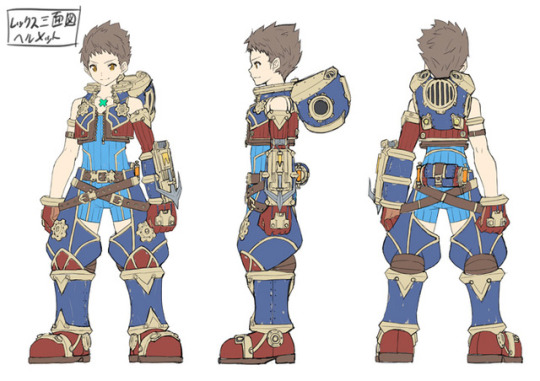
State of the Art: JRPG Spotlight-
Issue #1- 2017 at a Glance- A quarterly or bi-annual journal on the JRPG at large, focusing on recent releases, trends, quarterly reviews/analyses and upcoming release hype.
The other night I was getting yet even deeper still into the freshly minted minor-masterpiece that is Xenoblade Chronicles 2 when it dawned on me just how good 2017 was to the quaint little genre known as the JRPG. I knew all year while it was happening that some special games were getting released with a certain regularity, but now that the dust has fully settled, we can look back and be conclusively impressed by such a stellar stretch.
3 or 4 years ago I think people were getting ready to pen their moratoriums on why big developers and JRPGs should soon plan on never intersecting again save for small-scale handheld releases, and now here we are and Japan is seemingly back on top as far as role-playing goes. That return-to-form didn't always seem so inevitable as it is now that it's fully underway, especially after a somewhat shaky stretch for the genre during the 7th generation. Indeed, high-definition graphics and devs who catered to Gatorade-guzzling gamer bros seemed to not be the boon to the genre that old-school role-players really needed, and even the first couple of years of the 8th generation saw the genre to still be on slightly shaky ground, without a ton of great titles to point to from those initial years.
But then throughout the 7th gen a little franchise called Dark Souls (a JRPG in spirit, though not quite in practice, in many ways) started to build a little following, generating new interest in things like difficulty, customization, and innovative diagetic story-telling. As of the middle of this decade though, the genre still doesn’t have all that much of a presence compared to the late 90s heyday of JRPGs. Cut to 2016 though and Square drops FFXV which is a solid, if not-perfect realization of the 30-year-old standard-bearer of the genre, (a herald of sorts, if you will) and BAM. 2017 begins and in quick succession Nier Automata, Persona 5 and Breath of the Wild drop, all to stunningly positive reception. Now BotW, like Dark Souls, is not as much of a JRPG as the other 3 releases I hope to focus on, but Zelda has always had it's toe in the same waters as Final Fantasy and Dragon Quest, borrowing and simplifying elements of role-playing games from an action-adventure perspective, and in turn, also influencing those very JRPG franchises it seemed to pay homage to.
This wasn't just a coincidental blip of releases though, proved largely by the fact that all the way at the end of the year, Xenoblade 2 would also drop, and show yet again how the JRPG can be fresh and vital, and can be a Nintendo-exclusive at that. Indeed, I hope to demonstrate my thesis that it was a particularly strong year by triangulating my discussion around Nier A, Persona 5 and Xenoblade 2. Not only are these three very strong titles, they are also all pretty vastly different styles of JRPGs, which I think displays the health and potential of the genre even better than the fact that they are so individually good. First of all we have an industry veteran and mad-hatter in Yoko Taro finally coalescing a fully-realized vision of action-JRPG greatness by collaborating with Platinum games to make something as heady, and intellectual as it is well-designed and fun to play. That game is something like a Hegelian Philosophy PhD driving a Lamborghini in terms of the amount of stuff going on with the writing and character development, all while sporting a super classy luxury sports-car, six-cylinder engine. For long-time fans of Taro, I don't think this direction could have ever been predicted, though they may have secretly dreamed of such a fusion of form and function.

The best thing about how simultaneously weird and playable Nier A is for me is the way it hearkens back to the golden age of PS2 JRPGs for me personally. Without pinning it to a single PS2-era title, it gives me the same feeling that games during that console could consistently deliver on: a fully realized fantasy/sci fi world, a deep-yet-approachable combat system, a weird and very-Japanese, but also deep-as-hell plot, and a certain functionality that games like Kingdom Hearts 2, Rogue Galaxy and Final Fantasy XII delivered on back then. I don't mean to say it's derivative or stuck in the past, it's just that, the highlights of the PS2 days are my go-to precedent for what a good modern, post-16-bit JRPG is, since that equally sweet ps1 era can only be reasonably emulated on smaller and/or handheld retro-style releases. And while the story’s depth and esoteric nature recall the plot’s and worlds of PS1 and 2 greats like FFX, Xenosaga or Vagrant Story, the combat itself feels as fast-and-furious as hack-n-slash classics from then like Devil May Cry.
So while Nier had action-(j)RPG style gameplay covered, Persona 5 was there for all the turn-based devotees, and oh boy were we there for it also. That game was a huge victory lap for Atlus, who has built up a deep fanbase over the past decade, largely because of youtubers (at least in the west we can thank the cult-y presence of its fans online for the slow-burn development of an army of Atlus acolytes, whereas P3 and 4 were only barely noticed in the States back when they actually first came out.) And they finally capitalized on that hard-earned interest by finally following up P4 after nearly a decade, and while they were at it, they also showed everyone that fully turn-based (not even slightly active-time) systems can still melt faces, please crowds and feel fresh, which is no mean feat at all in a world where some question if turn-based is officially dead save for retro-homages.
And while Nier captures a kind of ethereal PS2-esque quality, Persona very literally pulls some of the PS2-era goodness into the future by updating and refining the awesomely deep and OCD-enabling systems of the now holy-grail-level PS2 era Persona games. Yes, wandering around Shinjuku, going on supportive dates with classmates, building up your relationships in general, and working a part time job between study breaks has been fully realized for the modern gamer, and it is glorious to behold.
And that takes us to Xenoblade which out of all the titles I might be most surprised by. Being a bit of a Xeno-noob, I wasn't sure if the release was going to be a major or minor event for role-players, especially given Nintendo's spotty track-record with the JRPG, usually sporting all of maybe one or two truly notable ones per generation, as well as their tendency to censor and/or smother developers. But alas, Xenoblade is fully-formed, proper, brimming-with-life and as deserving of the title of new standard-bearer to the genre as any of the other fantastic JRPGs released that year, many of which I won't even get to.
As is the case with the others, it seems to draw on PS2 era greatness in someways, by building on battle systems like the ones in FFXI and FFXII, while also being an actual descendant of the Xenosaga series that rocked that console, and also still draws on PS3-era titles that were successful (though smaller in number there were some good ones!) like Ni No Kuni and the Last Story. This is a round-about way of saying the combat system is an excellent take on the free-moving active-time auto-battling-but-with-real-time-triggers-style combat that started to show up towards the end of the PS2's life-cycle just when people were realizing the days of pure turn-based role-laying may be limited. And it also delivers on all those other check-marked boxes that any truly great and special JRPG must deliver on including: emotionally stirring and unique soundtrack, a deep and rewardingly complex story with all sorts of specific and detailed lore, a really nice visual style, and some incredibly beautiful locales. Okay that last thing isn't even a thing JRPGs usually have to deliver on, but it sure is a highlight. Some of the locations you move through during your travels in this game are breathtaking, and even more impressive than the similarly psuedo-cell-shaded style of Breath of the Wild, whose open-world Monolith Soft also worked on (though you can't climb all over these areas I should say).
I'm as blown away by the suddenly addictive combat (once it fully kicks in and you are given full control over 3 blades around the 15 hour mark) as I am by the surprisingly moving, funny and immersive story. I can be a little skeptical sometimes when approaching JRPG stories, but by all three of these aforementioned titles, we were treated to surprisingly mature and complex narratives, with refreshingly grounded and/or thoughtful characters. Indeed, with this many games firing on all these different cylinders (I didn't even mention the soundtrack to Persona 5 or Nier OMG), you know something special is happening.

So there you have it, three wildly differently styles of JRPG, only unified by their consistent top-tier quality. An old-school turn-based lite-novel hyprid, a full real-time action-RPG for philosophy students, and a MMO-style combat fantasy epic. And on top of all that there's myriad other fantastic releases, or even re-releases like the Final Fantasy XII Zodiac Age remaster of FFXII, one of my favorites and oft-forgotten FF titles that I think got overlooked slightly upon initial release precisely because of the way it showed other developers the way forward from pure turn-based combat.
And then the behemoth that is Breath of the Wild saw a tried-and-true franchise get fully revitalized in a way that drew on the weapon system of Dark Souls as much as it did the food system of Odinsphere of all games. And like I said, though not a true JRPG, it shows that role-playing adjacent titles are also showing a come-back. Survival components in video games were always the more practical, realist cousin to role-playing/stat-grinding after all.
So where do we go from here? Well 2018 will show us whether 2017 was a stand-out year or just the beginning of a trend, but all signs seem to point to an ongoing upward trend if releases like Monster Hunter World are any indication. Ni No Kuni 2 is due out soon, Octopath Traveler, which should make good on the idea of a retro-JRPG, and Kingdom Hearts 3 at the end of the year all help to paint the picture of an equally formidable year. Alas, Nippon is poised to continue its domination in coming months. All in all, fans of the genre should be very pleased, and if you haven't checked out one of the aforementioned titles get to it, because all of them are excellent, even if Xeno takes about 15 hours to truly get rolling and Persona takes a whopping like 20. All good things come to those who wait, after all.~
#xenoblade chronicles 2#xenoblade#nier automata#nier#persona 5#persona#jrpg#state of the jrpg#role-playing#role playing#role#playing#ps4#switch#turn-based#combat#real-time#state of the art
2 notes
·
View notes
Link
Key Takeaways
Like climbing a mountain, an organisation’s automated testing culture is somewhere between base camp (“we just write code”) and the summit (“we’re domain oriented and quality focused”). The test coach’s job is to help them reach the summit.
Even teams that are writing user stories and acceptance tests often don’t realise that they’re not yet at the summit; they’re forgetting to explore error conditions in depth.
A good test coach spends a lot of time listening and adapting the process to the project, and can learn as much from the team as they can from the test coach.
The test coach role is demanding and requires a broad set of skills, ranging from programmer and tester to “people person” and agile coach, even salesperson. But…
The reward is to see an organisation transition into one that’s domain oriented and quality focused, and working in a particular way to achieve this.
Automated testing is a culture that requires careful nurturing.
Actually, let me qualify that. Domain oriented, quality-focused automated testing is a culture that requires careful nurturing. It’s a state of mind, and either an organisation has it, or they don’t.
So wouldn’t it make sense for teams to have someone who can coach them on the testing mindset, while also being actively involved in teamwork?
It’s almost like we need some kind of (air quotes…) “test coach”…
The test coach role is a fundamental part of Domain Oriented Testing (DOT). It’s a way of instilling into the team a sense of product quality, pride in their code combined with a particular way of working that results in a system that’s more in tune with the business domain and requirements.
I’ve been developing and “living” the test coach role in a number of organisations, most recently (and significantly) at London-based fintech pioneers 11:FS. For their cloud-hosted banking services, software quality requirements are stringent to say the least, and their deadlines are suitably ambitious. So far, DOT has been providing great results for them.
How much help an organisation needs can vary, depending on how far along they already are.
Climb every mountain
Depending where the organisation’s testing culture already is, the journey might start right at the base of the mountain, or some way up:

Where on this journey is your organisation right now?
Nothing here needs fixing (base camp): I’ve written some code, what’s not to like?
TDD FTW: I’m about to write some code, but first I’ll write a failing test
Happy path: Our customers are shaping the user stories. Let’s use BDD to turn the stores into acceptance tests
Domain oriented (the summit): Let’s get the domain expert thinking about exceptions, alternate flows, unhappy paths, and what he/she wants to happen in each case. Then let’s turn these into test scenarios
I’ve worked at many places that were languishing at base camp (stage 1) particularly 15-20 years ago. Back then, much of the industry was stuck at base camp too. At one particular start-up in the early 2000s, I heard the question more than once, “Have you really known a unit test to catch a bug?”
The question by itself reveals why team culture has to change for automated testing to really work. The developers were cynically viewing unit tests as a panacea for catching bugs after the software was written. There are so many things wrong with this… to name a few:
Unit tests are really not meant to be regression tests; they’re too fine-grained
You write unit tests to catch bugs as you’re writing the code under test. If you’re adding unit tests afterwards, it’s already too late
If you want tests that are effective at catching bugs afterwards, you need a more “zoomed-out” form of tests - integration tests, in other words
In a well functioning automated testing culture, many forms of bugs don’t ever appear. It’s a bit like the compiler eradicating type-level bugs by preventing them at compile-time. Domain oriented tests (which we’ll come to) also help to prevent errors of understanding from ever appearing. So “did you ever see a test catch a bug?” is clearly meaningless in this case, as you would need to trace an alternate timeline where the same project didn’t have tests, in order to see if bugs would have been introduced.
The start-up team I mentioned did eventually progress to stage 2 on the mountain climb… to the extent that they began writing JUnit tests. However it was a timeboxed activity, showing that they still didn’t really “get it”. Not by coincidence, they went out of business less than a year later. They could never have progressed to stage 3, though, as they didn’t have clear business requirements to base their tests on.
Thankfully, the industry has matured considerably since that time, and on the rare occasions you might encounter a team who are still happy to remain at base camp, it’s increasingly a surprise… like seeing a lesser-spotted woodpecker in the wild.
Many teams remain at stage 2, even today. The developers are running the development culture (which kinda makes sense). They’re using TDD - or at least writing unit tests as they go along. They’re thinking in terms of code coverage - “Leave no function untested.” As a result, their tests are oriented towards the code.
If you’re introducing a more business-focused level of testing into such a team, you’ll likely face resistance, as the developers won’t really see the point. I’ve found they tend to see acceptance tests as duplicated effort. Sometimes the only recourse is to begin writing business-focused tests and show them the difference. Gradually win them over.
The climb from stage 3 is steep because the “cultural revolution” must leap out of the developer pit and into the larger organisation. Developers are generally pretty receptive towards improving their art and are often the ones banging the drums for change. But outside this group, the changes must be framed in terms of P&L and business prioritisation. This is often a tough sell, even if the results speak for themselves.
Another reason for the steep climb is that teams often stop improving. They believe stage 3 is the summit. After all, they’re writing automated acceptance tests and involving product owners in working through each user story.
But they may not realise that they’re leaving big gaps in the acceptance tests, as their focus is on a single desired outcome for each story. Hence the steep climb beyond stage 3 is a form of resistance, as they’re unaware of the “bigger picture” waiting for them at the top.
Luckily, when they do reach the mountain’s summit (stage 4), they’ll understand why being domain oriented makes such a difference to the tests and the overall project.
I’m using “domain oriented” to denote both the urge to drive tests, code and documentation from an executable business domain model, and to explore business scenarios in great depth, before any code for a particular story is written.
The test coach’s job is to help everyone in the project reach the summit. But the test coach can’t carry everyone up the mountain. He or she will need some level of buy-in, cooperation and all-round goodwill from the team, even when they’re all still at base camp and insistent that nothing about their project is broken.
So, how does the test coach get everyone to the summit?
How to be a test coach

The role is similar to software development-engineer-in-test (SDET), but with expanded responsibility to share the knowledge and enthusiasm for the discipline they’re introducing.
While an SDET tends to reside in one team at a time, the test coach’s role can span multiple teams.
Similar in principle to a Scrum master or agile coach, the test coach isn’t necessarily a specialist. They’re simply someone who champions the cause, works down in the trenches to help instill a cultural change among the developers if needed, works with the product owners, domain experts and management to help expand the stories into “lightly structured” scenarios, and collaborates on development work and writing of tests.
A test coach also listens to each team, and adapts the testing process if it isn’t working.
So as a test coach, with the “mountain” metaphor in mind, a typical day-in-the-life for you could involve any of these activities:
Following BDD, or at least a BDD-like process, and writing automated acceptance tests - Cucumber, Fitnesse, Gauge etc.
Writing and refactoring code, along with unit tests and component tests
Encouraging Three Amigos-style sessions where the BA, developer and tester expand a user story into its details - scenarios/examples, and so forth; each stakeholder provides their unique perspective on the problem
Listening and learning — the other people on the project have skills and experience too; use that to improve yourself, but also to adapt the process to the people and the project itself. For example I found this at 11:FS where they’ve embraced a reactive, CQRS-based microservices architecture. My goal initially was to introduce e2e tests for all the business scenarios including unhappy paths, but this would have made the acceptance tests too unwieldy and slow to run, or even fragile, as an individual microservice deployment could break some unrelated tests. Instead, we kept the happy path scenarios, and wrote the majority of unhappy paths as component-level tests, within each microservice. The result was good comprehensive requirements coverage, with a test suite that still completes quickly. In other words, we avoided the notorious “inverted test pyramid” antipattern… we actually ended up with more of a test diamond, with the majority of testing going on at the service level. That may not be ideal for every project, but in this particular case it’s been ideal.
Nudging the developers towards writing their tests in a domain oriented way: that is, testing business behaviour rather than the innards of their code A good example of this: recently I’ve been working closely with Parallel Agile (PA), a company with close ties with the University of South California (USC). PA’s main product is CodeBot, a cloud-based enterprise code generator. In fact, CodeBot is really more of an executable architecture generator, as it creates and deploys a complete server platform from a UML domain model. Such a “rules-intensive” project requires a comprehensive suite of tests, especially as the product continues to be extended with new capabilities. These tests include more low-level unit tests than I would normally write, as the underlying generator “engine” is so complex. However, we kept the unit tests focused on the business domain, by feeding it example class models from a number of business and technical domains. This approach also extended to the higher-level service tests, of course.
Nudging the BAs and product owners towards mapping out the business domain, and ensuring each story has been expanded into sufficient detail for a developer to pick it up, and for the acceptance test scenarios to be written. Doing this well involves exploring unhappy path scenarios far more than the happy paths. People like to focus on the goals (the fun stuff, really) and need frequent reminding to also think about edge cases and what they want to happen when things go wrong - or just happen differently. Among other benefits, this really helps improve sprint estimating. At one organisation a couple of years ago, we’d noticed a trend where the sprint burndown chart - showing the estimated amount of work remaining in the current 2-week sprint - would “burn down” nicely for the first week, then reverse direction and burn back up during the second week. The amount of work remaining often finished higher than when it started! It was only when we started to expand each story into test scenarios, and analyze the scenarios in detail that the problem became apparent. The team was estimating each story based on incomplete knowledge… we’d been doing “happy path estimating”, meaning probably 90% of the functionality in each story - error handling, business-centric alternate courses etc - was missing. This problem is surprisingly common, leading to frequent under-estimation of tasks and cost overruns; yet it’s quite easily addressed. This goes to show that a domain oriented testing approach can have a positive effect on the overall health of the project, not just on the state of the code and the tests.
Nudging the testers (or developers-in-test) in a particular direction, so that their acceptance tests are driven directly from the story scenarios, and similarly explore unhappy paths far more than the happy paths
Sure, that’s a lot of nudging. It might even seem like coercion, but the actual practice is far from it. Like moving a huge mirror inch by inch, you’re gradually coaxing the team’s frame of reference until your message suddenly clicks into place. This also helps stakeholders reach the right conclusions themselves, which further reinforces the result.
Of course, you can’t necessarily move the mirror on your own; this is why people’s buy-in is so important. Stakeholders will buy into the principles and goals of a process if they can see that it’ll make their lives easier, and result in a higher quality product.
Overall, the test coach is a demanding, highly skilled role. You must have a good grasp of all the disciplines you’re “nudging” the stakeholders towards. You must have great people skills, or at least a knack of presenting things so that people realise you’re on their side, working with them.
For example, at one company I was presenting the new automated testing strategy that we’d collaborated on, and murmurs went around (particularly from the upper management) that this sounded “too much like QA”. The company wanted code quality and tests, but they resolutely didn’t want a “QA department” as such. It took some digging to find out why; and the solution, it turned out, was more a case of strategic naming than making any huge changes.
“We want testers, just don’t call them QA”
In this agile climate, for many organisations QA has become a dirty word. However unfairly deserved, for many people QA is now synonymous with waterfall, big bang integration, process overload with long forms to fill out, and a department separated from the developers, promoting a “sling it over the fence to the testers” approach to software delivery.
But let’s be honest, a test coach’s purpose is very similar to that of QA: to introduce and maintain a process that gets the team focused on software quality.
How they go about it is different though. Like an SDET, the test coach works within each development team, involved in their day-to-day activities. There’s still a clear separation of responsibilities, but there’s also a shared understanding of any underlying problems, the business domain, and of what’s actually being delivered.
Test coaches encourage a highly integrated setup, with product owners, testers and developers all working together.
So even though a test coach fulfills the same set of goals as QA, they provide a way to introduce quality-oriented cultural changes into an “agile infected” organisation, while operating within the practices and principles that have made agile so popular. Is this post-agilism, perhaps?
0 notes
Text
What is SEO? (As Defined by 40+ SEO Experts)

SEO stands for Search Engine Optimization. Three little words that, for most people, invoke equal parts cold sweat and wild hopes as far as the success of their business is concerned.
The siren call of SEO is well known. It goes something like this:
Rank your website #1 on Google!
Get massive search traffic and passive exposure!
Profit!
But for many beginners, their SEO journey ends before it even begins. White‐hat versus black‐hat? Site audits? Backlink profiles? URL Rating and Keyword Difficulty? No thank you—I’ll be over here hitting “promote” on some Facebook posts.
As for more seasoned marketers, the struggle to keep up with an industry that moves at breakneck pace is real. What if the next Google algorithm update tanks my organic traffic? Will the tactics I’m using now still be relevant three years on? What should I be focusing on?
Somewhere along the line, we all end up asking the same question:
What is SEO, really? And is it all worth it?
Let’s ask the experts.
If you’re not already familiar with Ahrefs, we run an SEO blog—and we pride ourselves on an objective, data‐driven approach to our posts.
So we decided to do something way better than coming up with a definition of our own: we reached out to the best minds in the SEO industry and crowdsourced this ultimate “What is SEO?” post.
After combing through the 40+ responses, I found that most definitions fell into three categories:
Website or search engine focused (15);
User‐focused (15);
Larger strategy focused (14).
Almost an even mix, actually.
Of course, there were also some outliers that we’ll look at towards the end of this post.
1. SEO is about optimizing websites for search engines
It’s almost 30 years since the launch of the first search engine, but plenty of responses still align with the more traditional take on SEO. That is, what coined the term “search engine optimization” itself.
These definitions of SEO explore the process of optimizing websites to best fit search engine algorithms, all in the name of ranking higher in the search results.
SEO is the process of getting content to be crawled, indexed and ranked well in Google and other search engines.
Mass user acquisition via search engines.
SEO is the practice of positioning websites for higher visibility in search engines. When done correctly through best practices, testing, and hard effort, it typically works. Sometimes it causes headaches. May lead to industry friendships and a life‐long love affair with all things search.
SEO is the act of optimizing information for increased visibility on search engines.
This isn’t specific to a type of search engine, type of content, or even a website. If someone needs to find information online and someone else wants to appear for that search then SEO is the act of helping the content creator reach the searcher.
Along the way SEO touches on lots of other disciplines, but this is the simplest explanation. We identify what someone is looking for and work to appear for that query.
In its simplest form, SEO is about making a search engine’s job easier to find your website, understand the content of your website and score your website in terms of popularity and relevance. This can be achieved through many different activities including technical changes, website content, PR, UX and providing the best product and service out there.
SEO is Search Engine Optimization, the act of optimizing your website to show up higher in the search engines. At the core, the two biggest ranking factors for this are content and links, matching users’ expectation for that content, and being perceived as authoritative enough for the search engines to return. As SEOs, we all at a basic level optimize for these things. At a more advanced level, we think about and optimize for the 200+ factors Google has also mentioned are important to them. But if you focus on just those two, you’ll return quite highly (knock on wood)!
SEO is all about optimizing your site for search engines.
Which means regularly performing tasks like:
There’s so much more to SEO than SEO.
If you publish amazing content on your website, people are going to link to it. Which can significantly boost your rankings.
Is “content” SEO? Technically not. But it’s still a key part of SEO.
Let’s say your site has horrible UX. And people tend to bounce from your site because they can’t figure out what to do. Thanks to RankBrain, these “User Experience Signals” can hurt your rankings.
Is “UX” SEO? No. But it’s a must if you want to rank in 2018.
Let’s say you work hard to create a HUGE brand (like Mailchimp). Based on your brand alone, you’ll get links from authority news sites… and tons of people will search for your brand in Google. Both of which can help your SEO.
Is “branding” SEO? It’s not. But it’s the ultimate SEO superhack.
SEO is anything that helps your site get higher rankings in search engines. It includes the traditional stuff (like on‐page SEO). But to rank in 2018 you also need branding, UX, design, content and writing skills.
SEO is the process of helping search engines find the content on your website that best matches the intent of a user’s query.
To me, SEO is the process of optimizing your website, content, and assets in conjunction with building awareness of your content through links, mentions, etc.
Whether you love it or you hate it, SEO is the difference between having a successful website which ranks highly, attracts a ton of traffic and is extremely authoritative and a website that barely ranks and maybe gets a few hundred visitors a month. But what exactly is SEO? It is the optimization of a website to rank higher in the search engines which in turn attracts more traffic to your site.
The more effort you put into your SEO, the higher you rank, the more qualified traffic you get which equals more income for you. But how do you get started?
Well: Before you do anything else — be sure to perform a complete SEO audit of your site. How? Just use the Ahrefs Site Audit tool to do the hard work and then you can work through and fix any problems you may have. That will help you to craft the perfect SEO foundation to build on step by step while teaching you the fundamentals of SEO in a practical way rather than reading waffle like this!
SEO is organizing a website and its content so that search engines can crawl, read, index and properly rank it for relevant queries. The purpose is to get your message in front of people who are looking for it. If you sell shoes, it probably doesn’t help you much to get in front of someone who is looking for zoning regulations.
SEO is understanding the different SERP discovery opportunities that search engines provide — for example, Top Stories, Knowledge Panels, Featured Snippets, Maps etc – and making sure that your site is structured to be displayed in those features for relevant queries.
An SEO practitioner can range from your classic webmaster – a person who does virtually everything on a website – to someone who is very narrowly focused, for example, a person who only works on certain aspects of structured data.
There are many disciplines that impact SEO but being a good SEO practitioner doesn’t mean you have to master all, or any, of those disciplines, just like being a good marketer doesn’t require you to be a good copywriter or art director. An SEO practitioner’s job is to work with people in other functions to help them understand how they can affect organic search outcomes, directly or indirectly, as well as to learn what requirements and limits they work under that could impact the effectiveness of SEO.
Mats Tolander,Technical Search Engine Optimization Director Perficient
SEO is a wide topic to discuss. One instance of this is when you type in “SEO” on the internet and you get unlimited results from different sources. Simply put, SEO is how you manipulate search engines to take your website to the first page of the Search Engine Results Page (SERP) while you overtake other websites within the same niche or market through putting out fresh, informative content and being a trusted authority in your niche or market.
What is SEO? I guess from my point of view it’s ensuring that a website is technically correct in the search engines eyes, so checking Server Headers, Speed (caching or even if AMP is needed), to cannibalization and canonicalization issues, all the way down to HTML markup and site architecture.
David Naylor,Director of Digital Bronco
To me, SEO is the process of getting a brand more organic exposure from search engines. More often than not, this means getting “higher rankings” in Google, but for some businesses, this just isn’t feasible. Google’s algorithm has gotten increasingly complex (and biased) and some websites will never get rankings for certain keywords. However, that doesn’t disqualify your site — there are still opportunities for exposure through Google using platforms like YouTube, SlideShare or even guest posting on authority websites. For example, if you Google “white hat link building” and you’ll see my Ahrefs guest post ranking there. That post has driven a ton of exposure for my agency.
SEO is any optimization that helps someone get an answer from a search engine that they want. That could be a product, a piece of information, some entertainment or a personal action like finding a diary entry.
Despite the modern technologies powering search and moving things forward, SEO as a practice still comes down to creating an answer with sufficient expertise, authority, and trust (EAT) so the engine deems your content the best result for the query. This means that the exact same query should serve a completely different SERP according to the person searching and the circumstance to which they are conducting the search. As practitioners, all we can do is zoom out and take a broad view on our content and websites in order to fulfil Google’s needs at a strategic level and then get into the weeds with our content production and link development and experiment with tactical outputs and techniques to fulfil the broader strategy of being presented as an expert, with authority and trust.
2. SEO is about matching searchers’ needs to content
Every so often, someone comes along and proclaims that “SEO is dead.” The thing is that since the field changes so quickly, they’re usually referring to an outdated practice that failed to work for them.
What is the field moving towards, then?
Here’s an interesting trend I noticed in the responses: aligning content with search intent and placing users’ needs first.
SEO to me, if given an explanation that I’m interested in, is part reverse‐engineering algorithms and part reverse‐engineering human nature. It’s about using logic and “gut” to do what you think should matter and then relying on data to correct yourself due‐course. It’s certainly not the best definition I would use to describe SEO to someone else, but it’s what keeps me excited about the industry.
SEO is the art and science of connecting people to website content, through the medium of a search engine. Good SEO comes from a deep understanding of what potential audience members want to find on the internet, and how to deliver content that fits this need, aligned with a technical setup that enables search engines to recognize that your content is a good fit for their users. Websites that have the most SEO success are strong in all three areas: the audience, the content and the technology.
I’d say SEO is anything and everything that goes into making your site better for search engines and users. I know the “users” bit is not typically considered by everyone but from a link building perspective, my goal is to have users actually click on the links I build. We want to rank well, get great qualified traffic, and have our sites be useful to as many people as possible.
There are two answers to the question “What is SEO?”. The first one is simple: SEO stands for search engine optimization, the art, and science of optimizing websites for organic traffic from search engines.
The second answer is not so simple because the term SEO is outdated. SEOs now have to optimize for users AND search engines and have to cover a broad spectrum of disciplines, from technical optimization to content, content marketing, conversion optimization, user experience, and taxonomy. On top of that, Organic Traffic isn’t (and shouldn’t be) exclusive to get from Google, but also Youtube, Amazon, and other platforms.
Hence, SEO should be the systematic optimization of websites and content for users and bots in order to get organic traffic from search engines and social platforms.
#SEOisAEO — SEO is fast becoming AEO, Answer Engine Optimisation, the art and science of communicating to answer engines the most appropriate and credible answer to user queries for which you are relevant.
SEO is the process of surfacing content that fulfills the needs of a searcher. This can span across many search ecosystems, and it often does.
Matthew Barby,Director of Acquisition Hubspot
At its core, SEO is simple. It’s understanding what your users are trying to achieve and then helping them achieve that in a way that both humans and search engines can understand.
SEO is the process of aligning a site’s content focus and the underlying technical reinforcement of user experience signals with searcher intent needs. This is based on maximizing the highest quality experience where nuanced relevance to those intent needs is sought out. Given that search engines are a form of user, and technical conflicts or barriers to understanding exist, it’s up to the role of SEO to address that reality. The more conflicts or barriers that exist within a site’s presence at the topical and technical level, the less likely the crawl, indexing, and ranking sequence will be able to properly interpret what site owners hope to achieve.
SEO is the result of having a great business that invests in educating and/or entertaining their audience through valuable content. It’s creating and being the best answer to the myriad of questions that exist in your industry and Google recognizing that through the smooth technical structure of the site, the valuable and in‐depth content and the links that exist from other quality websites around the web back to the great content you are creating.
Traditionally, SEO refers to the practice of getting more traffic from search engines. What people tend to mean by that is the idea of getting traffic by typing in queries at a search box in a web browser. This is where traditional search algorithms apply, such as keywords, content quality, and links.
However, today, it makes sense to take a broader view of the definition of SEO. For example, obtaining traffic from the Google Assistant is also rightly considered SEO as well. Perhaps the better way to think about SEO is that it’s the practice of obtaining visibility and/or traffic in response to user requests for information regardless of when and where such requests take place.
SEO attempts to perfectly match a users’ search intent to its content across all devices and platforms.
For me, SEO has changed both direction and depth. It is no longer just about doing a bit of on‐page work and adding a few backlinks (although these are still needed and very important).
SEO now means making sure that someone has a pleasing user experience on your website. When someone visits your website and completes an action (contact, purchase, etc.), then your site is meeting requirements that Google is looking for. It is meeting the intent of the searches being performed and will be rewarded accordingly.
This speaks volumes about the direction that Google is taking and how smart their algorithms are.
So the next time you think about adding a bit of text to a page in the hope it helps push you up the SERPs, try and think about the user experience once someone gets to the page.
Andy Drinkwater,SEO Consultant IQSEO
SEO is equal parts art and science. It can help you identify the questions your customers (or potential customers) have; how you can (or if you should!) answer them; and how you can ensure that — when those customers ask a search engine — they find your answer in the search results, driving more of the right kind of traffic to your website.
Andrew Cock‐Starkey,SEO Consultant Optimisey
What is SEO? For me, SEO is making sure I achieve the organic traffic goals of a specific domain. For every search (either textual, visual, voice‐based) the challenge is to create a fitting experience for search engines and their users. This is completely different in every possible situation and that makes SEO a challenging job. Some domains need content, others need links whereas some domains are technically way behind on their direct competitors. Never a dull moment.
In my opinion, SEO is simply a phrase which relates to someone with a specific understanding, appreciation for getting ‘the most’ out of any activity which is undertaken which could be a website/URI/App in relation to organic search.
Knowledge + Experience + Application of knowledge + Juggling + Dealing with Bullshit = SEO
3. SEO as a strategy
Hold up a second. It’s kind of nice and all to put into words what SEO is, but what does SEO mean in practice? How does it fit into an actual business or marketing strategy, and why should you care?
That’s the final popular theme among the responses: going broader to address SEO in relation to business objectives.
This in itself is pretty telling of just how tightly interwoven SEO is with business development these days.
Search Engine Optimization (SEO) is the process of optimizing and promoting your website to increase its visibility in Google or other search engines. The end goal is to get more organic traffic, leads, and customers from search engines. In a small number of cases, SEO is also used for reputation management (suppressing “negative” results and replacing them with “positive” results).
Although SEO requires the most upfront investment (time and money), it’s the most scalable customer acquisition channel over the long‐term. I would also argue that it’s the most affordable (as far as CAC) in the long‐term.
Whether you call it SEO or something else, the main purpose of our job is to create and modify websites so that search engines and users find them useful. Our goal is to recommend changes to help the business get more customers and make more money. Those changes may be as follows:
technical changes to help search engines better crawl or understand the site
content changes to make it so that your site is the most helpful of its kind
SEO is constantly changing. But, in my opinion, as long as websites exist, there will be a huge need for SEO!
SEO is a form of marketing that leverages Google’s organic search. When you write content that is optimized for a certain keyword, then Google will rank you on the 1st page when someone searches for that keyword. While there is a lot more that goes into it, you can boil SEO down to high‐quality content with good on‐page optimization combined with good quality backlinks. The beauty of SEO is that once you’re ranked on Google, you will often stay there for a long time and be able to reap the benefits of free traffic hitting your site daily.
At this point you are kind of in a “set and forget it” mode, versus paid traffic campaigns require you to monitor that campaign’s health every day. Organic traffic tends to convert into customers easier than other forms of traffic too. That being said, most SEOs get obsessed with the ranking portion of driving traffic to their site and often forget to do the other side of marketing.
Don’t forget that you should still be investing in powerful copywriting principles to get your traffic over the finish line from just a website visitor to an actual lead or customer.
SEO is the process of finding opportunities to reach your target audience through search and then executing a strategy to increase the frequency of your desired conversion (pageviews, leads, revenue, users, etc).
SEO is search engine optimization; the practice of optimizing your digital presence for findability via search engines. How well do you rank when people search for you or what you offer? And how do you rank better?
That can include surprising networks‐ not just Google but also YouTube, the second biggest search engine. And it can include surprising activities‐ not just blogging but also networking and podcasting and even attending events, if it helps you get more website links to your content, which Google sees as votes from others of your credibility and importance. SEO is viewed as the organic (non‐advertising) side of search.
There are two major types of digital marketing: search and there is social. Within search, there are two major types of marketing: SEO and search advertising such as Google Ads (which some people call “search marketing” but I think that is a confusing term for people). SEO work includes a lot of geeky technical stuff like redirects and htaccess files that requires knowledge of HTML and web server technology.
To achieve search findability and SEO success, you’ll need expertise and action from geeks, marketers, networkers, salespeople and more. SEO takes time, but it’s the long‐term investment. Ads are quicker, like getting a job to get paid now, but SEO pays off big in the long run, like a retirement plan. All serious companies should do SEO, search ads and social media.
When I describe SEO to people who aren’t familiar with what I do, I usually say something like, “I help businesses make changes to their websites and marketing to help ensure that when people use a search engine like Google to search for topics having to do with their products and services, their website is what comes up.”
To expand on that a bit, I think SEO is about marketing a business online, using organic search as a channel. Doing so means understanding how people use search engines to make purchasing decisions for your clients’ products and services. It also means understanding how search engines like Google figure out whether or not a given result is a good result for a query. From a technical standpoint, this means making a website as easy as possible for search engines to find, crawl, and understand. From a marketing standpoint, this means applying that understanding of the customer journey to help ensure that the site is answering people’s needs when they arrive there from search. Done right, SEO not only makes organic search a powerful marketing channel in its own right, it also makes organic search a tool for growing the client’s brand.
Ruth Burr Reedy,Director of Strategy Upbuild
Once it was a tactical, technical channel designed to manipulate visibility in search results. As SEO popularized, we started to see just how important its role was in digital marketing overall.
SEO can be a powerful digital marketing channel, providing an opportunity to improve a brand’s recognition and qualified traffic. Even though it’s not a small investment (in most cases), its propensity to return huge results is obvious – as long as you stay committed.
SEO is digital marketing. Over the years, SEO has evolved so much that it has already become an all‐encompassing marketing discipline. SEO has become more than just search engine optimization.
A decade ago, a few tweaks on the website (i.e., metadata & content) and building links to it is enough to compete for better organic search visibility. But these days, to truly succeed in SEO, your business (not just your website) should be:
Technically superior (technical SEO and site performance)
Able to provide the best experience possible to its intended web users (content quality, relevance, UX, conversions, and other user‐engagement metrics).
Well‐branded — that people would talk about positively, socially share and link to (in which sentiment analysis, entity recognition, E‐A‐T, link building, digital PR, and a lot more are all in play).
Data‐driven — to give a better direction to the site’s overall traffic/revenue generation campaign (analytics, keyword research, content gap analysis, forecasting).
SEO is the process to grow a site’s organic search visibility towards its target audience with the goal to increase its traffic, conversions and profits.
Aleyda Solis,International SEO Consultant & Founder Orainti
The definition for what we talk about when we talk about SEO is changing dynamically. Six or seven years ago, SEO was mostly focused on getting links from directories, press releases and so on. Back then only a few SEOs (if any) would focus on the technical aspects of how you should optimize your website past H tags and meta titles/descriptions.
This has changed dramatically. I will go as far as to say that most people today look at SEO as a more technical field than a way to get links. SEO is also about links, but it is much more than that — it’s about being up to date with the latest trends in web technology and challenging the industry by e.g. testing how Search Engines cope with current JavaScript Frameworks.
SEO was always about being creative and looking for new solutions. This hasn’t changed. SEO was and still is about being flexible and agile to stay ahead of the curve.
Bartosz Góralewicz,Co‐founder & Head of SEOElephate
What is SEO? It’s a process that works with a variety of digital marketing components with the end result to improve your visibility in the eyes of those looking for answers and information. In short: SEO is no longer chasing the ‘rankings’. SEO is chasing the answer.
Search Engine Optimization has come to mean far more than it used to. Originally, SEO simply meant the implementation of accepted best practices for visibility and findability, as recommended by Google and other search industry leaders. Today, however, to me, the phrase “search engine optimization” includes a wide variety of activities, both on‐site and off‐site, that help ensure that a website is not only found, but that it stays there, and that it performs well too, converting users into customers and clients.
SEO is the art and science of coupling the completion of a businesses objective (usually generating revenue) to an effective online strategy that harnesses traffic gained from ranking in search engines.
SEO is the practice of professing to know something about which you know nothing while convincing others who know they know nothing, that you know something, with the goal of making money.
SEO is a discipline of study into how information retrieval works for the world’s largest search engines. To do so involves understanding how people search, why they search, what experience they receive online as a result of a search, and how to optimize their experience with the goal of aligning site content with user needs. Major search engine professionals’ goal is to give their users a great experience on their products. So aligning content, architecture, data, and usability in an additive way to search queries also adds revenue value for websites and brands online.
Special mentions go to…
Tangible love for the industry:
SEO is a lifestyle! Meeting people across the world during my keynote speeches, exchanging knowledge and bringing a lot of quality traffic is what I love the most. SEO is very different from any other industry. Challenging, constantly forcing people to learn more and finally with a lot of social human‐to‐human dimension. The greatest thing that could happen to me 🙂
Lukasz Zelezny,SEO Speaker & Consultant
And to end things off, an answer so meta that I couldn’t fit it in anywhere else:
Over to you
A huge thank you to everyone who contributed their thoughts.
I hope this post has answered some burning questions and sparked some thought on the evolution and potential of SEO.
Have something to add on (or challenge)? Maybe a definition of your own to share? Let us know in the comments below!
This content was originally published here.
0 notes
Photo


Artists: Anna Daučíková, BRUD (Aditya Mandayam), Chiara Fumai, Mark Ther, Than Hussein Clark
Exhibition title: School of Pain
Curated by: Michal Novotný
Venue: Art in General, New York, US
Date: November 15, 2018 – January 26, 2019
Photography: all images copyright and courtesy of the artists and Art in General, New York
In Masochism: Coldness and Cruelty, 1967 book by Gilles Deleuze, the author contradicts the convergence of sadism and masochism, that in clinical practice were and still often remains integrated into the entity of sadomasochism. For Deleuze both Leopold von Sacher-Masoch and Marquise de Sade are not only writers and representatives of a sexual perversion but rather embodiments of two different world views and at their time entirely new forms of expression.
Sade’s works are all about the the language’s way of imperative and descriptive factors that transcends to demonstrative function. In Sade the “the point (…) is to show that the demonstration is identical to violence. It follows that the reasoning does not have to be shared by the person to whom it is is addressed any more than pleasure is meant to be shared by the object from which it is derived.”1 That’s why in Sade’s books, so often the systematic verbal description precedes the actual perpetration of vicious acts. This is to illustrate that the general existence of law enables the tyrant to exist, that law entitles the tyrant, as much as reason allows for the existence of negation. That’s also why we encounter the cer- tain accelerating repetitiveness and monotony of his obscene descriptions, as much as the apathy of his heroes, that underlines the cold and the systematic part of reason. But Sade’s books are in this sense overly ironical. They somehow appropriate, embody of what they criticise.
Sade attacks the existence of law by turning its constitution upside down. In the classical conception law is justified by the idea of higher good, that we can access via reason. This is precisely why Sade illustrates how the idea of evil is incomplete and unreachable. As Deleuze writes: “The rage and despair of the sadistic hero when he realises how paltry his own crimes are in relation to the idea which he can only reach through the omnipotence of reasoning.”2
In a way Sade was the first avantgarde artist who used the structure, the system of power generates against the system itself. As Adorno would call it – the alienation of the alienated, the action of resisting the alienation with more extreme form of alienation. This technique, this method however turned out du- ring the 20th century according to Keti Chukhrov3 as itself to be essentially “nihilist and negative, and could be sustainable only in its radical indigestibility as opposed to capitalism’s libidinal economy. (…) [this move ] can [therefore] only be self-destructive, can only bring to the hush-up, to zero, to end, to the end of the artistic; because the capital can only allow the impossibility of the artistic, its collapse, and the negative mimesis of that, might also in the end become an attraction, unless the negation is complete.”4
Sade himself progressed from unknown and forbidden author to closed circles of the avantgarde, to finally end up as nowadays mainstream literary hero. Most probably however also read literally. As Adorno writes in Dialectics of Enlightenment “The liberation went further than its humane originators had intended. The market economy it unleashed was at once the prevailing form of reason and the power which ruined reason. (…) The affinity between knowledge and planning (…) has its counterpart (…) in the sexual teams of Juliette, in which no moment is unused, no body orifice neglected, no function left inactive.”5
With simplification we could say the 20th century belonged to Sade. Both Chukhrov and Groys6 have evidenced how contemporary art “detaches itself from the rationalism of the Enlightenment, but remains a theoretical and cognitive practice as opposed to art’s sensuous parameters as they used to be.”7
For Chukhrov sensuous doesn’t mean some- thing emotional rather than intellectual, but more an embodiment of an idea or concept, the meeting of notion or idea with the matter or a thing. Most of contemporary art’s message is constructed and pro- duced by intellect, but not as an idea, but rather as speculation.
The accent on alienation of modern and contemporary art blocked out any effort to conceive the situations, existences, that might have escaped the logic of alienation and the urges of critical theory to reflect and to act. As Chukhrov writes, maybe, because pa- radoxically, the modernist or contemporary artist not only despises the alienated world in rhetoric, but also unconsciously finds libidinal attraction in it. That is somehow a key double, that we can already find in the way Sade is being read.
Chukhrov follows the term “human resignation” in the writings by Mikhail Lifshitz, that “was aimed to dispute the approach to emancipation exercised by avant-garde’s constructivist wing and to blame it in the exaggeration of the role of biopolitics and social engineering: in the constructivist practices the issues of organization, systemic arrangement, or biopoliti- cal management prevailed over the very procedures of life or reality. Even though the avant-garde made its own attempt to merge art with life when disputing modernism’s nihilism and hermeticism, it instead of- ten rather superseded life with itself.”
As was mentioned, while Sade’s core lies in demonstration, for Deleuze masochism is all about persuasion. The masochistic hero appears to be educated and fashioned by the authoritarian woman, but basically it is he who forms her, dresses her and prompts the harsh words she addresses to him. Masoch himself was placing advertisements in newspapers and signing contracts with the women in his life. This educational undertaking and its risks, the submissions, contracts and torments the masochists undergo are all steps in the pursue of an Ideal. But the ideal is not platonically dematerialised one, but sensual, carnal, more close to mysticism and ritual with reversals and reduplications in the allocation of roles and discourse. Severin, the hero of Venus in Furs, takes as his motto, the doctrine of “supersensual”, from Goethe’s Faust where “ubersinnlich” relates to Sinnlichkeit, as flesh, sensualitas.
Deleuze describes how the masochist is able to deny the reality of pleasure at the very point of experiencing it, how the pleasure is postponed for as long as possible and thus disavowed. “The aesthetic and dramatic suspense of Masoch contrasts with the mechanical, cumulative repetition of Sade. (…) Repetition does occur in masochism, but it is totally different from sadistic repetition: in Sade it is a function of acceleration and condensation and in Masoch it is characterised by the “frozen” quality and the suspense.”8 This explains why coldness is the essential feature of perversion, and why it is present both in the apathy of sadist, where it plays the role of theory, and in the ideal of the masochist, where it figures as fantasy. Coldness is a metaphor for de-sexualisation that allows for consequent re-sexualisation. In masochism “the function of the description subsists, but any potential obscenity is disavowed or suspended, by displacing the descriptions either from the object itself to the fetish, or from one part of the object to another part, or again from one aspect to the subject to another.”9 “Fundamentally, masochism is neither material nor moral, but essentially formal”10 and dramatic.
It was illustrated how the heroes of Sade subverts the law, but the masochist in contrast doesn’t submit to it, neither. Sadist attacks the law with the upward movement of irony to the higher principle of good above the law. Masochist, according to Deleuze, uses a downward movement from the law to its con- sequences. Instead of irony, masochist applies humour. “The very law which forbids the satisfaction of a desire under threat of subsequent punishment is converted into one which demands the punishment first and then orders that the satisfaction of the desire should necessarily follow upon the punishment.”11 Thus it demonstrates the law’s absurdity. It allows for such application of the law, that results in every case for the opposite of what might be expected. Such as with the whipping instead of preventing and punishing the erection, provokes and ensures it. “The masochist is insolent in his obsequiousness, rebellious in his submission; in short, he is a humorist, a logician of consequences, just as the ironic sadist is a logician of principles.”12
There is precisely one main point why Deleuze wrote the book on masochism. And it is also his main point against Freud. In the end of the book he demonstrates how nor sadism nor masochism are about direct connection of pain with pleasure, pain is here only an effect, but about repetition. “Instead of repetition being governed by the idea of experiencing or re-experiencing pleasure, repetition runs wild and becomes independent of all previous pleasure. It has itself become an idea or ideal. Pleasure is now a form of behaviour related to repetition, accompanying and following repetition, which has itself become an awesome, independent force. Pleasure and repetition have thus exchanged roles, as a consequence of the instantaneous leap, that is to say the twofold process of de-sexualization and re-sexualization.”13 That’s also why large part of the book is devoted to claim the quantitative accumulation in sadism and qualitative suspense in masochism, that are both relations to reiteration.
Chukhrov notes that “many modernist, avant-garde and conceptual art-practices didn’t merely reduce its practice to theoretical mind; it also deplored such condition and subverted the inevitable totality of theory into a radical negative gesture, into the radical moment of actualization.”14 This moment is negative as it has to do with the collapse of perception and the capacity to understand. But then with some cognitive leap, the understanding and misunderstanding coincide in some sort of “supra-cognitive” paradoxical moment. Contemporary art in this way compressed realisation of artistic contents, of an art-work and its impact into this one cognitive, critical moment, but this also made the contemporary artwork instantaneous, momentary regardless to its actually duration, or reification. Example for this can be the conceptual art’s overuse of semiotical index, that preserves the gap between the two correlated elements, the third one symbolising them being ab- sent. That leads to the collapse of temporality previ- ously indispensable for sensuous involvement, but also allows for quantitative accumulation, perpetual motion and permanent revolution. This sort of art fair engagement where art works are being instan- taneously read and immediately proceeded to the next one, as much as the quickly growing quantitative production and accelerating change of focal points in contemporary art.
Chukhrov continues that sensuous involvement is not so much about any empirical sharing of certain experiences or rendering them, but rather about the encounter with the phenomena or event that chang- es the producer in some sort of metanoic transfor- mation imprinted afterwards in the art-piece. In any way imagining the sublation of alienation would presuppose a totalitarian redemption, or imagining utopian pictures of non-capitalism in the midst of capitalist alienation. Or it would presume disregard- ing of the initial and insurmountable estrangement of existence. What however can be done is rather to intervene sensuously exactly into this painful gap between the alienated reality and the potentiality of de-alienation.
“Why believe in the idea of a perfect world?” asks Masoch in his book The Divorced Woman. What we need to do is to “put on wings” and escape into the world of dreams.
-Michal Novotný
0 notes
Text
Death of the Developer: Interactivity in video games
In some capacity, all media requires two parties: a creator, and a consumer; someone to make the thing and someone to experience the thing. Interactivity is important to all forms of media, but in video games especially, being able to interact with the media is foundational. Player participation is integral to video gaming—without a player manning the controls, the video game is functionless. This in turn means that video games provide a space for total interactivity—not only in terms of the “vanilla” software that the developer provides, but also in terms of player modding, cheat codes and customization. They are a space for collaboration, for creativity, and for players to have total control over how they experience art. Examining video games that provide players with opportunities to directly affect how the game is played, as well as examining other aspects of gaming generated by players like mods, cheat codes, and speedruns, demonstrate that authorial intent is ultimately irrelevant and it is the player who in the end has full control over the narratives of video games.
Video games are highly interactive experiences. In an online article, the American Society for Aesthetics defines video games as “’strongly interactive’ because their users’ inputs help determine the subsequent state of play.” They require participation from the player in ways that books or films do not require from their readers and viewers. This results in experiences that are unique to both the player and to the moment in which the player is playing the game; for example, if someone plays the same game twice, the second time around they may have an easier time in some parts of the game than they did the first time. This results in a different experience every time they play the game, though the narrative itself may not change. This is even truer in regards to choice-based games, like Bioware’s Mass Effect series.
In Mass Effect, the player assumes the role of Commander Shepard, is given the opportunity to decide whether their Shepard is male or female, customize their appearance, and make choices during interactions with non-player characters (NPCs) that affect their relationships with these characters. The game even includes a mechanic which measures the amount of “paragon” or “renegade” decisions that the player makes throughout the game, and having a higher amount of one or the other will open new opportunities and relationships within the game. This gives the narrative itself customizability, allowing the player to assume full control over what happens within the context of the story. Choice-based games give players a higher level of investment for the characters, and adds replay value to the game, as each time a player plays that player can make new choices and end with different outcomes. Bioware understands the opportunities that customization in video games can bring—that is, the way that players can tailor the narratives to themselves, feel more like a part of the game. Choice-based games like Mass Effect recognize the importance of player involvement.
There is another level of interactivity in gaming that contributes to the popularity of choice-based games like Mass Effect:, At a basic level players make decisions in-game that may encourage them to replay it as well as to feel more committed to the various characters, but that is not the only way of customizing video games. Many players delve directly into video game code, reshaping it, and adding elements to create an entirely unique gaming experience. This is referred to as “modding,” short for “modification.” Most mods are simple additions to a game—different clothing or armour for characters to wear, new textures for the landscape, and so on. However, modding can also result in a total overhaul of both the story and the gameplay itself.
Harvard Law Review offers a detailed overview of game modding in an article titled “Save the Mod: in support of total-conversion modified video games,��� including a discussion of the legality of mods that do a complete overhaul of the game, and why developers benefit from game modding. As it is explained in the article, “Modded content can extend the shelf life of a property by introducing constant updates and revisions to an otherwise outdated game” (792). Again, replay value is an important element here, allowing players to experience the same game in different ways, or even simply prolonging the original experience. In a particularly immersive game, it is appealing to be able to play the game for longer periods of time, to spend more time in the game’s universe. This is part of the reason the Harvard Law Review argues for the benefit of modding in video games, to allow gaming communities to grow and change the games they play organically as both technology and interests change as well. Furthermore, replay value is important in terms of cost, with many new releases by big name developers like Bioware or Bethesda running around the sixty to eighty-dollar mark upon their initial releases. All of this is nothing to say of official downloadable content, or DLC (content provided by the game developers that add elements to the game like new skins, maps, and so on), which often also cost money.
So we can see why free player-generated modded content is important to gaming—it is an inexpensive way to add more playability to a game, which in turn means that games become outdated less quickly. However, to speak about game modding as if it is all a serious artistic attempt to add new elements to a game is, strangely, a bit reductive. Many mods are created with a sense of humour in mind. In fact, one of the most popular mods for Bethesda’s Skyrim is a mod which transforms every dragon in the game into Macho Man Randy Savage. This mod has become one of the most infamous mods available for the game.
Skyrim is rife with possibility for comedic modding, as exemplified in IGN’s video “9 of Skyrim’s Craziest Mods.” This probably has to do with the game’s setting—it is a hilariously surreal experience to see Thomas the Tank Engine flying around the Nordic wilds—but also with the accessibility of the game’s code. In fact, players, regardless of their modding experience or expertise, can change the functionality of the game while playing it. This is done using cheat codes. These are codes that players can input while playing the game, and usually they have something to do with the amount of damage a player can deal, the speed with which they run or even the size and placement of various objects. To see a fantastic example of the lengths to which cheat codes can go, we can look at the McElroy brothers’ YouTube series Monster Factory.
Monster Factory began as a project by brothers Justin and Griffin McElroy in 2015. The goal of the series is to take games with character customization, like Skyrim, and using the tools provided in-game, create the most ridiculous looking character they possibly can. These characters are often based on an outside source, for example their Skyrim character is based on the cartoon cat Garfield, and then taken to a new level of surrealism. During each video, younger brother Griffin McElroy plays the game while older brother Justin provides additional commentary and laughter.
After the character creation process, the brothers then proceed to the gameplay itself. In this portion of the videos, Justin and Griffin try to come up with a unique narrative for the character they’ve created, and often this is a narrative that does not mesh with the original narrative of the game. The brothers often use cheat codes, especially in Bethesda games which allows for the free use of these codes. In their Skyrim video, for example, after they create G.A.R.F.I.E.L.D., Griffin claims to not be interested in the vanilla long form experience of Skyrim and enters in a cheat which enables “God Mode,” which gives him infinite health, stamina, and other perks. This moment is a great summation of the Monster Factory series, but it also shows the lengths to which players can use cheat codes to change their experience. As an open world game, Skyrim is meant to give its players a long, complex series of missions and characters to interact with. Griffin, however, completely subverts this experience by entering in cheat codes which allow him to bypass the tutorial stage of the game, as well as the need to garner experience points to level up. By using cheat codes, Griffin completely ignores the intent of the game, instead using the game as a tool to create a unique experience for himself, his brother, as well as the thousands of viewers who watch their YouTube videos.
When Griffin uses cheat codes to undermine the original gameplay of a video game, or when he installs mods to change the game entirely like in his Touch the Skyrim series, he is participating in a remix culture. Michele Knobel and Colin Lankshear define remixing as a “means to take cultural artifacts and combine and manipulate them into new kinds of creative blends” (22). Griffin takes the vanilla gaming experience, twists it using cheat codes and turns it into a new narrative of its own, one that perhaps makes less sense than the original, but all the same is something entirely distinctive.
In the final moments of the video, Griffin proclaims that, “The final boss of Skyrim is that I’m going to see if I can break my computer.” With this new goal in mind, he then spends the rest of the video using cheat codes to spawn dozens of horses, dragons, and make G.A.R.F.I.E.L.D. very large. Obviously, this is likely not what the developers had in mind when they made the game, but Bethesda’s intent is, ultimately, not what is important. Rather, what is important is Griffin’s (and by extension, every player’s) ability to turn a video game into something new, into something totally personalized. As G.A.R.F.I.E.L.D. looks out across the landscape, unfazed as a dozen dragons shoot fire at him in a scenario that was never intended to happen, we are reminded that video game developers may provide us with the tools for an experience, but ultimately it is the player who gets to decide what that experience is going to be.
In January 2015, YouTube user Sethbling uploaded a video of himself playing Super Mario World, completing what is known as a speedrun. The purpose of a speedrun is to play a game the fastest way possible, often skipping over entire portions of the game to do this. Speedrunners will also frequently exploit glitches in the game that developers have missed, using these glitches to bypass otherwise necessary parts of gameplay. Sethbling does precisely this in the linked video, performing a complex series of tasks which result in a glitch that enables him to reach the end of the game in less than five minutes. Speedrunning has become an integral part of gaming culture, with entire speedrun marathons for charity existing, as we see with Games Done Quick. There is an entire speedrun subculture in the gaming community, with specific rules as to what one may or may not do during a speedrun.
Speedrunning may seem to do the inverse of what modding and cheat codes are trying to do—that is, to shorten a game rather than to prolong the experience of a game and to add replay value. They may also seem like a reductive way to play video games, ignoring the time and effort developers spend building visuals and narratives. However, in very much the same vein as mods and cheat codes, speedruns allow players to play a game in a way that is unique to them. Speedruns are also very much a part of remix culture, in that they take a video game and do something different with it that forces us to consider it in a new way. Mods and cheat codes might intend to give players more to play with, but perhaps in a way speedruns take things one step further by shortening games, by exposing the mistakes in the original code and working with them, turning the mistakes into tools to accomplish a goal. In this sense, speedruns turn video games back in on themselves. Maybe this is what makes speedruns so popular and so enjoyable to watch, they encourage a kind of self-reflexivity in video games, forcing games to confront their own errors while at the same time embracing them, finding creative and interesting ways to work with these errors.
In the end, this is what being a player is all about. We can play games as developers intend them, we can experience the narrative for what it is, but there is always more to explore, more to do. Video games are a medium where authorial intent becomes almost completely irrelevant. Mods and cheat codes demonstrate the malleability of video games, the innovation of players. Perhaps speedruns, mods and cheat codes are most interesting because they show the possibility of a medium that is fully interactive, where players can add, remove, and remix as they see fit, and where they can, in the words of Griffin McElroy, “Punch a hole in the [expletive] universe.”
Works Cited:
The Elder Scrolls V: Skyrim. Bethesda. 2011. Video game.
Knobel, Michele, and Colin Lankshear. “Remix: The Art and Craft of Endless Hybridization.” Journal of Adolescent & Adult Literacy, vol. 52, no. 1, 2008, pp. 22–33.
Mass Effect. Bioware. 2007. Video game.
“Monster Factory: Exploring Skyrim with Garfield.” YouTube, uploaded by Polygon, 7 October 2016, https://youtu.be/VHR0EfYACAI
“SPARE THE MOD: IN SUPPORT OF TOTAL-CONVERSION MODIFIED VIDEO GAMES.” Harvard Law Review, vol. 125, no. 3, 2012, pp. 789–810
“Super Mario World -- 4:49.8 Former World Record Speedrun w/Credits Warp Glitch.” YouTube, uploaded by Sethbling, 22 January 2015, https://youtu.be/gECESOoU8Es
“Video Games, Interactivity, and Art.” aesthetics-online.org. 31 March 2017, http://aesthetics-online.org/?page=TavinorVideo
2 notes
·
View notes
Text
Elon Musk just unveiled wild Starship plans for "the Moon, Mars, and beyond"
https://sciencespies.com/space/elon-musk-just-unveiled-wild-starship-plans-for-the-moon-mars-and-beyond/
Elon Musk just unveiled wild Starship plans for "the Moon, Mars, and beyond"
Elon Musk, the founder and CEO of SpaceX, addressed planet Earth on Saturday night about his latest plans to “extend consciousness beyond Earth” using a towering steel spaceship.
Standing between two rockets that represented both the future of SpaceX and its nail-biting past, Musk delivered his talk to more than 100 people from the company’s fast-developing launch site in Boca Chica, southeast Texas.
Behind Musk was a shorter rocket called Falcon 1, which – after three catastrophic failures in 2006, 2007, and 2008 – finally delivered a small payload into space for the first time. That mission’s success also prevented Musk and SpaceX from going broke.
“Eleven years ago today SpaceX made orbit for the first time,” Musk said of that first successful Falcon 1 launch, on September 28, 2008. “If that fourth launch had not succeeded, there would have been curtains. But fate smiled upon us that day.”
Yet as he spoke, all eyes were fixed on the 164-foot-tall (50-metre-tall), stainless-steel rocket ship behind Musk that SpaceX had finished assembling only hours before his speech.
“I think this is the most inspiring thing I’ve ever seen,” Musk said of the vehicle, called Starship Mark 1: a critical prototype for a planned system called Starship.
A complete Starship may stand 40 stories tall at a launch pad, ferry dozens of people into orbit at a time, and eventually send crews to the Moon and Mars.
“There are many troubles in the world, of course, and these are important, and we need to solve them. But we also need things that make us excited to be alive,” Musk said.
“Becoming a space-faring civilisation – being out there among the stars – this is one of the things that I know makes me be glad to be alive.”
“Do you want the future where we become a space-faring civilisation and are on many worlds, and are out there among the stars? Or one where we’re forever confined to Earth?” he said.
“I say it is the first.”
But Musk’s audacious vision needs a vehicle to carry it out, and to him that vessel is Starship.
SpaceX has made radical changes to its Mars rocket over the past year
In September 2018, Musk presented a carbon-fibre version of a Mars vehicle called Big Falcon Rocket. He also introduced Yusaku Maezawa, a Japanese fashion billionaire, as a major funder of the system’s development – and the person who will fly around the Moon in a SpaceX rocket in 2023.
A couple of months later, though, SpaceX abandoned the carbon-fibre design and switched to a stainless-steel variant. Musk announced the reimagined spacecraft as Starship that December.
Since then, SpaceX built and launched a crude prototype called Starhopper and finished Starship Mk 1 (which Musk said may fly in a month or so). Those prototypes are work toward a Starship system that’s fully reusable – that way, no multi-million-dollar rocket parts are wasted, and the only major cost to launch is fuel.
“The critical breakthrough that is required for us to become a space-faring civilisation is to make space travel like air travel,” Musk said. “This is basically the holy grail of space travel.”
SpaceX posted a video to Twitter (below) on Saturday that imagines how Starship would work.
Starship will be the most powerful rocket in history, capable of carrying humans to the Moon, Mars, and beyond pic.twitter.com/LloN8AQdei
— SpaceX (@SpaceX) September 29, 2019
In the animation, a Starship vessel is stacked on top of a giant rocket booster, called Super Heavy, that’s equipped with up to several dozen car-size Raptor rocket engines. The booster hauls Starship much of the way toward orbit, detaches, and falls back to Earth.
Once refueled, the booster then launches another Starship to meet the first one in orbit, refuel it with methane and oxygen – liquids Musk says can be mass-manufactured on Earth as well as Mars using carbon dioxide, water, and solar energy – and send it on its way.
The biggest changes to Starship’s design include a refinement of its lower wings, flipper-like upper canards, and the addition of hexagon-shaped heat shield tiles lining the spacecraft’s belly.
SpaceX got rid of three wings that also functioned as landing legs. Instead, Starship – as currently envisioned – now has six pop-out landing legs and two canard-like wings.
The wings and tiles are crucial to safeguarding Starship as it returns to Earth at 25 times the speed of sound and plows through the planet’s atmosphere. This phase, called reentry, generates a searing-hot plasma that can destroy an unprotected spacecraft.
“For a reusable ship, you’re coming in like a meteor. You don’t want something that melts at a high temperature,” Musk said, emphasising the need for steel (most rockets use aluminium or carbon-fibre). He also noted that stainless steel is about 50 times cheaper by weight than carbon-fibre composites.
Starship’s redesigned wings should help the vehicle maintain lift, slow down more gradually, and spread out the heat of reentry, while the thermal tiles absorb that energy.
Once the ship reaches denser atmosphere, Musk said the wings will help steer Starship as it falls toward a landing pad.
“It just falls like a skydiver, and controls itself, and then it turns and just lands,” Musk said. “It will be totally nuts to see that thing land.”
Kimi Talvitie – a spaceflight enthusiast, software engineer, and artist – built an impressive 3D model of a “skydiving” Starship (below) using details Musk shared ahead of his presentation.
youtube
More
‘I think we could potentially see people fly next year’
Though Starship may be years away from being fully realised, Musk shared some shocking notions about how it may stack up against all other rockets – even SpaceX’s own partly reusable Falcon 9 and Falcon Heavy launchers.
Musk calculated that, in an ideal scenario, one Starship system could launch to space and return three times per day, or about 1,000 times a year. Assuming each launch can fly about 150 tons of payload into orbit, that works out to about 150,000 tons per year.
That’s more than 333 times the mass of the football field-size International Space Station.
Meanwhile, he said, all of Earth’s rockets launching today might together deliver no more than 300 tons into space.
“We’re talking about something that is, with a fleet of Starships, 1,000 times more than all Earth capacity combined. All other rockets combined would be 0.1 percent, including ours,” Musk said.
“But you kind of need that if you’re going to build a city on Mars. It’s gotta be done.”
The rapid reusability of the system, when Musk emphasised is essential, could also move Starship into an operational state much faster.
“I think we could potentially see people fly next year,” Musk said. “We can do many flights to prove out the reliability very quickly.”
Musk said SpaceX hasn’t yet figured out how it plans to keep people alive inside its Starships, in terms of oxygen, food, water, and waste, let alone on the surface of Mars. But he added there’s a definite need for “regenerative” life support systems, which recycle and conserve all the supplies humans need.
“I think for sure you’d want to have a regenerative life support system,” Musk said. “Regenerative is kind of a necessity. I actually don’t think its super hard to do that, relative to the spacecraft itself.”
Despite Musk’s optimism, though, fully functional regenerative life support systems have yet to be achieved in elaborate facilities on Earth, let alone in spacecraft.
Musk wants to save humanity before its ‘window closes’
Musk’s drive in creating Starship is not just about feeling good about the future, but also, in his mind, rescuing humanity from certain doom.
“As far as we know, this is the only place in this part of the galaxy, the Milky Way, where there is consciousness,” Musk said of planet Earth.
He explained that it took about 4.5 billion years for that “consciousness” – we humans – to evolve, but that we have maybe a few hundred millions years left before our ageing Sun begins to expand, heat up Earth, and make our home planet uninhabitable.
Musk referred to this as a window of time for consciousness.
“That’s all we’ve got, OK? Several hundred million years,” Musk said. “If it took life an extra 10 percent longer for conscious life to evolve, it wouldn’t have evolved at all, because it’d be incinerated by the Sun.”
Though this or other humanity-destroying calamities are a long way off, Musk doesn’t want to waste any time while our window to spread among the stars, as is evidenced by the frenetic pace of SpaceX’s Starship rocket development program.
“I’m optimistic by nature, but there’s some chance that window will not be open for long,” Musk said. “I think we should become a multi-planet civilisation while that window is open.
“And if we do, I think the probable outcome for Earth is even better because then Mars could help Earth one day. I think we should really do our very best to become a multi-planet species, and we should extend consciousness beyond Earth, and we should do it now.”
This article was originally published by Business Insider.
More from Business Insider:
#Space
0 notes
Text
Original Post from SC Magazine Author: Doug Olenick
IT personnel working the trenches in the fight against malicious emails know that financial transactions — and the various documents that support and accompany those transactions — provide malicious actors seemingly endless fodder for clever phishing attacks designed to separate legitimate organizations from their money and reputations, as well as their customers, clients, and partners.
Indeed, fake invoices, RFQs, POs, ACH documents, and remittance forms collectively constitute the “social engineering” backbone of innumerable phishing campaigns. And hapless employees keep falling for them, clicking through malicious links and opening malware-laden attachments — often with nary a thought to the potential consequences — bringing malicious actors and their sophisticated malware inside their employers’ networks.
Over the past few months we have observed the increasing use of yet another type of transaction-based social engineering scheme designed to hook companies dependent on government contracts: the invitation to bid. In what follows, we’ll take a look at a number of actual phishing emails reported to us by customers using the Phish Alert Button (PAB).
The Evolution of the Fake Bid Phish
Fake bid invitations have been around for a while, to be sure. In many respects, they are a natural variation of the fake RFQ, which leverages a targeted organization’s search for new business to dupe its employees into opening the digital door to security breaches, costly down time, and financial mayhem.
Consider this confused, yet highly malicious phishing email, which can’t seem to decide whether it’s a fake PO or fake RFQ:
Despite the obvious mechanical stumbles in the email body, this phish fairly represents the blizzard of fake RFQ emails currently hitting users’ inboxes. And it packs a mighty wallop in the attached .RAR file:
That’s right: a good old-fashioned executable backdoor trojan. (And you thought those were going out of style!)
From that humble fake RFQ, though, it’s just a hop, skip, and jump to this more polished fake “invitation to bid” on a potentially lucrative “airport project” allegedly being run by a well-known, upscale hotel chain.
This phish is noticeably more polished than that fake RFQ, though it, too, has its problems.
More so than the phish we looked at earlier, however, this fake “invitation to bid” relies heavily on the enticing promise of more information lurking behind that malicious link — even going so far as to provide specific directions for completing and submitting the bid form.
Alas, it is all a mirage. Here are the same instructions — this time for an “improvements project” being run by a health care organization:
Like the first phish, though, this bogus “invitation to bid” remains short and to the point. And that is the most obvious difference between these less ambitious “fake bid” phishes that we’ve seen now for several years and the newer “fake bids” targeted at government contractors.
Going Large
Governments tend to be large, sprawling organizations. Apparently, the phishing emails targeting private contractors who bid for government projects have to be just as big, just as byzantine, and just as bureaucratic. Or so it would seem from the steady stream of fake “invitation to bid” phishing emails we’ve been tracking over the past 4-6 months.
Let’s take a look.
Here is the opening move in a routine phishing email purporting to hail from the Department of Transportation. (We’ve also seen similar emails spoofing the Department of Commerce.)
The level of detail and the disciplined construction of the email body is a noticeable improvement on the previous “fake bid” email we looked at just above. For all we know, this email might be based on an actual DOT email that the bad guys managed to get their hands on. Whatever the case, this well-built phishing email is only the first step in long slog to our final destination.
The email urges recipients to click the “BID” button in the attached PDF to access the bid portal on the DOT’s website. Here is the first page of what turns out to be an unusually long, four-page PDF:
Notice that there is no BID button. This first page is devoted entirely to selling the ruse with still more carefully constructed, convincing detail. Users will actually have to scroll down to the second page to find the BID button amidst a host of other detail.
To say this kind of arrangement in a phishing email is unusual would be an understatement. In fact, it’s almost unheard of. In 99.9% of other phishing emails we’ve encountered, the bad guys aim to get the money link in front of users as quickly as possible. Often that link is in the email body itself. When the bad guys do elect to relegate it to an attachment (typically to reduce the chances that it is flagged by scanners), that attachment is almost always a single page with the malicious link itself placed front and center before the victim. Even in the rare two-page malicious attachments that we occasionally encounter, the link is still on the first page.
There is a reason the bad guys are eager to get their money links before users as quickly as possible. The more clicks you put between users and their final destination — whether it be an adware installation laden with EULAs, privacy policies, disclaimers and optional crapware installs or a malicious phishing email such as we have here — the fewer the number of users who will actually make it through to the end. Simply put, superfluous clicks bleed impatient users.
If nothing else, the execution of this phish speaks not only to discipline of the malicious actors running the campaign, but to their own confidence that they have understood their “audience” (for lack of a better term) well enough to take this kind of risk. After all, what’s a few extra clicks when a big government contract is in the offering?
But wait! We’re not even close to being finished here. That BID button in the attached PDF takes users to a professionally designed spoof of the DOT’s own website, which greets them with still another set of instructions that must be closed to continue.
Once that instructions box is closed, the magical BID button finally comes into view.
The BID button itself ends up opening a login box that — at least for anyone with a functioning brain — ought to be a red flag.
No, the DOT is likely not accepting AOL logins. And they would be utter fools to accept punters from Yahoo!.
Whatever else can be said of this phish, it must win some kind of award for “most elaborate credentials phish” — like, ever. (We certainly haven’t seen anything that comes close.)
Variations on Variations
Over the course of the past few months, we have seen several variations on this phish. For example, this fake “invitation to bid”…
…takes users through a PDF (with the BID link on the first page)…
…and on to an equally well-designed spoof of the website for the Department of Commerce:
Apparently, the bad guys thought better of continuing to accept GoDaddy logins for some reason. (AOL and Yahoo! users are still good to go, though.)
Interestingly, some of the latest variants of this phish have ditched the PDF attachment altogether — combining elements of the old email body and PDF into a single, jumbo-sized email that puts the BID button before potential marks much more quickly.
As we have stressed in earlier blog posts, the bad guys are always learning and adapting. The fact that this campaign is still going after six months, though, tells us that the malicious actors behind it must be enjoying some level of success with it. And we’ve certainly seen evidence that the bad guys were right to think they could get traction with this kind of elaborately designed credentials phish.
The DOT phish we laid out above, for example, generated considerable interest — even excitement — amongst employees at the targeted organization. The initial recipient in that organization wasted no time in pursuing it…
…and, in so doing, spreading that malicious email to others in the organization:
Malicious actors certainly don’t lack for incentives to pursue this kind of phishing campaign, as government contractors could very well be sitting on plenty of attractive data, ranging from extensive contacts with well-heeled clients and customers to logins and other special access to government agencies. And then, of course, there is the money. For, in the end, it’s always about the money.
Put simply, a well-executed credentials phish against a government contractor could yield a bonanza for malicious actors working this kind of campaign. And the elaborate detail and disciplined construction of the campaign certainly reflects that.
Conclusion
Even if you’re not in the government contracting business, this kind of phishing campaign ought to make you sit up in your chair. If nothing else, it clearly demonstrates the lengths to which malicious actors will go to wangle something as simple — and potentially destructive — as a set of login credentials from your users and employees. The bad guys are just that determined, just that disciplined.
It should also serve as a warning that the days of counseling users to spot phishing emails by looking for grammar, spelling, and syntax errors are long gone. Your users won’t help you keep the bad guys out by becoming grammar nazis. And that training session you did last year in the break room with a box of doughnuts and a PowerPoint deck will forever be a distant, foggy memory.
What your employees need is New-school Security Awareness Training, which teaches them what to look for and regularly tests their mettle against simulated phishing emails based on the latest phishing campaigns actually out there “in the wild.” And the “wild” we speak of is not something scary “out there,” lurking just beyond the tall trees of your firewall. It’s in your users’ inboxes right now, today, and each and every day.
The post Bad bid: Malicious actors target government contractors appeared first on SC Media.
#gallery-0-6 { margin: auto; } #gallery-0-6 .gallery-item { float: left; margin-top: 10px; text-align: center; width: 33%; } #gallery-0-6 img { border: 2px solid #cfcfcf; } #gallery-0-6 .gallery-caption { margin-left: 0; } /* see gallery_shortcode() in wp-includes/media.php */
Go to Source Author: Doug Olenick Bad bid: Malicious actors target government contractors Original Post from SC Magazine Author: Doug Olenick IT personnel working the trenches in the fight against…
0 notes
Text
A new lawsuit is sorely testing the Zcash Founders Reward model
The Electric Coin Company is being sued, highlighting the sheer messiness of the Founders Reward scheme.Key pointsThe Zcash Electric Coin Company is being sued by a former employee.The lawsuit casts a light on some of the downsides and complications of the Zcash Founders Reward funding model.The Electric Coin Company is struggling financially, and its fate is bound to that of Zcash. The Electric Coin Company (ECC) is one of the key entities behind Zcash, one of the word's foremost privacy cryptocurrencies. It's now being sued by former employee Simon Liu over allegations that it failed to compensate him as agreed for his work. Here's what allegedly happened in a nutshell, according to the lawsuit: 27 October 2016: Simon Liu signs on with ECC, and is granted vested stock options of 15,000 units of stock.31 December 2018: ECC allegedly says something to the effect of "actually, we never really created a stock option plan."4 January 2019: Liu is all like "where's my stock options?" and asks to see the company books.8 January 2019: "[ECC] stated [Liu] has no right to demand a books and records inspection."23 January 2019: ECC said it was going to issue new units, diluting everyone's existing share.22 May 2019: Liu expresses concerns about the impending dilution, is allegedly told to "stop spreading incomplete and inaccurate information and unverified rumours" lest his employment be terminated.28 May 2019: Liu resigns as senior engineer, citing failure to receive stock options, intolerable working conditions and unfair threats of termination.29 May 2019: Liu sues ECC and 50 anonymous others for US$2 million.Show me the electric money The "units of stock" referred to in the lawsuit are "membership units" in ECC. This is both an equity share in ECC itself as a business, plus the system by which the Zcash "Founders Reward" (FR) is distributed among founders and vested ECC employees. The FR is a cut of all the Zcash (ZEC) coins being mined. It's currently 20% of each block reward, and will eventually drop to 10%. According to the latest ECC financial report, the total ZEC mined each month in the second half of 2018 were being distributed like so: The top 80% is the portion that goes to miners, the bottom 20% is the combined Founders Reward. We know that ECC CEO Zooko Wilcox was earning 2,033 ZEC worth some $305,000 per month as of July 2018. Extrapolate that to prices of $60 and assume no other changes, and it suggests he's earning some $122,000 per month today, equivalent to a 13-14% share of the total funding that goes to founders and vested employees. Meanwhile, the total ECC monthly operating expenses were $700,000 per month it says, distributed as such. The Electric Coin Company budget, as you can see, is only getting $367,500 of that though. It's operating at a significant loss, which the financial report happily admits. "The company's operating cost in the second half of 2018 averaged $700k per month. An additional $180k a month was used for employee compensation during the period. As such, the company has been running at a significant deficit," it shrugged. It has about $5 million in ZEC and USD in the bank, and assuming everything stays as is, it will be out of money by October 2020. The Electric Coin Company has made no secret of the fact that it's walking on thin financial ice. Something doesn't add up? The total ECC annual operating budget is $8.2 million and it's going broke, while the company's CEO is getting $1.464 million per year. Assuming these numbers are correct, the Electric Coin Company CEO's earnings are equivalent to 17.85% of the struggling company's annual budget. Even in a world of disproportionately high-flying executives, that's pretty wild. Of course, you can't really separate the amount going to founders and vested employees from the company's finances itself. The Founders Reward is hard coded into Zcash as a system that currently diverts 20% of the mining reward to the specified Founder wallets, so those founders, including Wilcox, are directly funding the Electric Coin Company with voluntary donations of their own. That's where the 2.8% comes from. This means that if you're not a founder, your payment as an employee of Zcash is dependent on good old fashioned employment contracts and trust. If the lawsuit is true, it's a trust that's being abused. "[ECC] also promised to compensate [Liu] by paying him a share of the "Founders Reward" in proportion to his limited liability company ownership equivalent in option membership units... [ECC] did not have authorization to issue common stock to employees in 2016... [ECC] did not grant any incentive stock option to [Liu] to purchase Zerocoin's common stock," the suit says. Perhaps recognising the disproportionate amount of funding being diverted to the founders and vested employees, the ECC agreed to release additional share units in in June 2019, which was allegedly one of the things that sparked the lawsuit in the first place. And then there's the Zcash Foundation, which is getting a bigger slice of the funding than ECC itself for performing what sounds like a very similar function. It's being funded by a pre-agreed portion of the Founder Rewards. "The Zcash Foundation's mission is to be a public charity dedicated to building internet payment and privacy infrastructure for the public good," it says of its purpose in life. "Electric Coin Co. builds software in support of our mission to empower everyone with economic freedom and opportunity," the company says of its purpose in life. Some cryptocurrencies created non-profit organisations to serve as the chief entity behind their projects, while others created for-profit business entities. These entities have typically been funded with ICOs or pre-mines. Zcash created both, and then funded them both with a system that doles out ongoing mining rewards to a small handful of key players who then voluntarily fund these two organisations. It's quite different. And then things got weird What we have here is a company's piece of code that's vacuuming up an enormous portion of its product's total earnings and giving it to a team of executives and investors, only some of whom are employees of the company, who then donate some of it to the company they are employees of. A portion of the executive earnings is also diverted to a separate charity organisation whose board members also include some founders of the company. What started as an effort to imbue the organisation's finances with a new level of transparency have also made the entire thing wonderfully opaque and complicated. This is reflected in Liu's lawsuit. Not only is it targeted at the Electric Coin Co. itself, but it's also aimed at 50 anonymous "John Does," who are together alleged to have breached their contractual obligation to grant equity (a share of the Founder's Reward) to him. Presumably those John Does are founders reward recipients who agreed to dilute the supply of founders reward units to help address the funding crunch the Electric Coin Company - the company rather than its mish-mash of investors and founders - are experiencing. So who's going to foot the bill for this lawsuit? And how about the next lawsuit, and the compliance hurdles bound to face a company that's building an anonymous digital currency? The Electric Coin Company itself, as a business, certainly doesn't have the budget. Alms for the tech company The Founders Reward was meant to encourage long term interest in the wellbeing of Zcash, but it functionally appears to have turned into a system where a business is dependent on charitable donations from its own founders to manage routine expenses. History says those founders have not tended to be overly generous. Plus, like any open cryptocurrency, Zcash is largely dependent on volunteers to survive, but there's not a lot of incentive to start volunteering when there's also a team of well-paid founders and investors hanging around. The Founders Reward is also a revenue model that doesn't offer much room for flexibility or growth in the Electric Coin Company business itself. You can't easily hire people to expand as needed - especially if they want to be paid in real money rather than ZEC - and you're also firmly wrapped up in the volatility of crypto as a whole. It also means there's a constant undertow of selling pressure running through Zcash from the founders and miners who need to fund their operations, and if the most recent ECC financial report is any indication another price drop could be disastrous for the Electric Coin Company. If the company goes under, who's going to pay its creditors? What about back-pay for its employees, or suppliers? Will the courts try to garnish the Founders Reward? Plus, if ECC goes bust ZEC prices would almost certainly plummet, instantly making everything worse for everyone. If ECC is necessary for Zcash it probably needs a more reliable funding mechanism than those founder donations. And if it's not necessary, why does it exist? Zcash is a grand experiment in more than one way, but it's having a tough time in the face of real world conditions. Also watch Disclosure: The author holds BNB, ZIL at the time of writing. Disclaimer: This information should not be interpreted as an endorsement of cryptocurrency or any specific provider, service or offering. It is not a recommendation to trade. Cryptocurrencies are speculative, complex and involve significant risks they are highly volatile and sensitive to secondary activity. Performance is unpredictable and past performance is no guarantee of future performance. Consider your own circumstances, and obtain your own advice, before relying on this information. You should also verify the nature of any product or service (including its legal status and relevant regulatory requirements) and consult the relevant Regulators' websites before making any decision. Finder, or the author, may have holdings in the cryptocurrencies discussed. Latest cryptocurrency news Picture: Shutterstock https://www.finder.com.au/a-new-lawsuit-is-sorely-testing-the-zcash-founders-reward-model
0 notes
Text
Mystic Vale Review
I confess I have been somewhat lax in my boardgame-fanboy duties as of late. We are inundated with all and sundry new releases each year (mostly clustered around the fall conventions) and generally get served more new games than we know what to do with. This inevitably means some worthy releases pass by without enough notice. Mystic Vale is the latest to cross-over from cardboard to the app store(s). The result is a surprisingly punchy lightweight, rapid-fire push-your-luck game, remixing relatively new trends in mechanics (deck-building & customization) with the tried-and-true (set collection, engine building). It is a good game and faithful app, but a little flat and perfunctory as well. Mystic Vale is generally a worthy super-filler, and the digital app gets the job done.
To cleanse the land of corruption, competing tribes of druids graft on ever-more-potent magical allies, animal spirits and the like to turn the tide. Every player starts with an identical deck of cards and takes turns drawing from the land’s energy to fuel more magical improvements. But the tainted land is strong as well and will leave greedy players empty-handed.
There’s a Mario Party minigame where the players take turns inflating a comically oversized balloon until it pops, exploding with (again, comedic) force and knocking out contestants one by one until there is only the winner left. The spirit, if not the mechanic, of push-your-luck, is crystallized into this image. Players can calculate the risks and independently decide how far they want to push their luck for a greater reward. Mystic Vale does this with its Spoiled Lands, drawing every turn until three corrupted symbols appear. The player can choose to draw more cards, one by one, increasing their rewards in the process, but also risk busting and ending their turn prematurely with nothing to show for it. Push-your-luck is so satisfying because it breaks a large risk down into delicious increments. It’s difficult to do well, aside from very pure, refined implementations (e.g. Can’t Stop).
To its credit, Mystic Vale make it one of the central decisions of each turn, and then tasks successful players with spending their mana & spirit symbols to further enhance their decks. Each deck cycles through 20 cards with a top, middle, and bottom region which can each be enhanced with purchases from a common pool of cards. The game’s iconography is crystal-clear, and its elements as stripped-down as can be.
In addition to the primary resource, mana, there are four elemental symbols as well as a ‘guardian’ subtype with tribal synergy. Most purchases simply enhance a deck’s mana and victory point yield during the harvest, but the bigger swings in ‘tech’ improvements come from the vale cards. These are also purchased after the harvest, but instead of using mana, players must have a match of the symbols of the vale. A few give straight-up victory points, but the more interesting offerings give unique effects (bonus mana, avoiding spoilage, wild symbol conversion) to dramatically accelerate the game’s pace.
The game feels aggressively midrange for such a naturalistic-shamanistic setting, for the whole affair is over in under twenty turns (Which passes in no time at all on the app). It ends just as things really start taking off for the players, kinda like with Splendor. It has achieved an amazing balance of brevity and strategy, for players must constantly assess which engine to build and how. Pretty much every card is viable and competitive, some with niches smaller than others. Mana and timing constraints mean that even winning decks often have jury-rigged, rag-tag elements mixed in with the rest.
The endgame comes so quickly because the pacing is up to the players. Instead of a set number of turns, the game is scaled around a victory point pool. Once it is completely divvied up amongst players, the game is over. More involved multi-card synergies will generate gonzo points in a single turn, but are they worth the lengthy set-up? Alternatively, is it worth scrimping a few victory points each turn if everyone else is planning for a deferred late game? It’s a simple but elegant change which turns game length into another strategic element to be decided by the dynamic equilibrium generated by the players.
The app makes the art look inorganic and forced, as if the graphical assets were used to recreate the tabletop visual as literally as possible. (They also appear to scale poorly). Functionality and legibility are top-notch. Music and layout are both serviceable, and the app has a touch of whimsy about its loading-screen text, but generally this implementation is a by-the-numbers affair. It is good but not to be oversold, like when the game boasts of its ‘card crafting system’. Lastly, Mystic Vale has both an in-game rule reference, a card compendium, as well as the obligatory introductory tutorial series, so props for thoroughness on that front.
Now for the bad news. Everything Mystic Vale does well recalls a stronger instance in another game. As an experience or an instruction in game design, it’s masterful. But there are other lightweight games I love more, and other quick-playing games with a little more control or strategy on tap. The game itself couldn’t be further than kitchen-sink, but in terms of gaming niches this is precisely the trap it falls into. Maybe this is the hobbyist curmudgeon in me, but it feels as if Mystic Vale’s strengths do not actually further its appeal.
Mystic Vale is refined and sharp, better than most of its kind, that of a mid-range, easy-to-learn, decently competitive multiplayer deck builder. Its individual components are better represented by other games, and honestly it isn’t really that strategic, but it is extremely well-made and fun. The app is a fairly priced way to experience it, with decent AI and timed multiplayer. Good, but not excellent.
Mystic Vale Review published first on https://touchgen.tumblr.com/
1 note
·
View note